A State-of-the-Art Review and Numerical Study of Reinforced Expansive Soil with Granular Anchor Piles and Helical Piles
Abstract
:1. Introduction
2. Research Method
- surveying the database and selecting keywords,
- assembling and screening relevant papers,
- comparing the different foundations and identifying research gaps,
- applying numerical modeling to compare helical and granular anchor piles.
Surveying the Databases and Keywords
3. Field Identification of Expansive Soil
- The soil contains montmorillonite (a highly active mineral with a high swelling potential found in clay).
- The natural water content of the soil is close to its plastic limit.
- A source of water is available for potentially swelling soil.
4. Types and Suitability of Foundations
5. Fundamental Building Solutions for Expansive Soils
5.1. Reduce or Prevent Swelling
- Removing and replacing the expansive soil: If the layer of moderately expansive soil is immediately below the foundation, remove it and replace it with improved soil. When correctly compacted, the replacement layer will distribute loads better and reduce the adverse effects of swelling on the foundation (Lytton et al. [70]; Rao et al. [71]; Murthy and Praveen [72]; Walsh et al. [73]; Ahmed [74]; Srinivas [75]). The effectiveness of the removal and replacement method depends on the thickness and soil type of the replacement layer. A thin, impervious cap may prevent surface water infiltration into the underlying expansive clay. In contrast, a granular replacement layer may encourage deeper wetting of the remaining expansive soil.
- Changing the soil’s characteristics: Gromko [76] provides several ways to reduce, if not eliminate, heave in expansive soils. Economics and workability will dictate the selection of one of the following strategies:
- Controlling the level of compactness: Gromko [76] concurs that maintaining the degree of compactness is one of the most practical and cost-effective ways to reduce heave in expansive soil. A soil’s swelling potential diminishes when compacted on the high side, possibly 3–4% above the optimum moisture content. However, in cases where the overall heave exceeds 35 mm, a slab on grade will not perform well.
- Stabilization through chemicals: Chemical stabilization of expansive soil with various stabilizers, such as fly ash, lime, or cement, has dramatically minimized heave; however, contractors use lime stabilization more than any other chemical agent to stabilize expansive soil. Mixing 4% to 8% lime with plastic clay reduces the plasticity index of the topsoil layer while increasing its load-bearing capacity (Gromko [76]; O’Neill and Poormoayed [77]; Bowels [4]; Prusinski and Bhattacharja [78]; Moayed et al. [79]; Belabbaci et al. [80]; AL-TAIE et al. [81]; and Mahedi et al. [82]).
- Pre-moistening of expansive soil: pre-moistening is another method for increasing the soil moisture content by immersing an area in water. Jeyapalan et al. [83] stated that submerging the expansive soil in water before building attains most of the estimated heave. Slow water seepage through highly plastic soil, on the other hand, may make this time-consuming. A 10–15 cm thick layer of sand, coarse gravel, or granular soil on top of the area will, according to Gromko [76], provide the contractor with an excellent working surface during and after pre-moistening. This layer reduces evaporation, adds a minor surcharge, and creates a level, uniform subgrade.
- Controlling the soil’s water content: One of the most effective ways to minimize the heave of expansive soil is to manage its moisture content. Moisture control technologies applied around the perimeter of structures will reduce wetting or drying under the foundation. Impermeable barriers (such as retaining walls and geotextile membranes), proper drainage systems, and vegetation control will maintain moisture levels [76,77,84]).
5.2. Creating a Flexible Building Style and Designing a Resilient Foundation System
5.3. Isolating the Structure from the Expansive Soil Environment
6. Deep Foundations in Expansive Soils
6.1. Granular Anchor Pile
6.1.1. Granular Anchor Pile Installation
6.1.2. Previous Research on Granular Anchor Piles
- The granular anchor piles significantly reduced both the magnitude and rate of heave. Compared to an unreinforced expansive clay bed, the full-depth granular anchor pile reduced heave by 70%, 87%, and 92% for 100, 150, and 200 mm diameters, respectively. Relative movement along the pile-soil interface mobilized uplift resistance, reducing heave. A larger interface surface area (diameter) created stronger uplift resistance and less heave, as shown in Figure 7. The results of laboratory-scale model granular anchor piles installed in expansive clay beds corroborate this performance [91]. Granular piles also act as drain paths due to their high hydraulic conductivity, reducing the time for moisture stabilization and heaving equilibrium [92,93].
- Increasing the length of the granular anchor piles increases the resistance to upward movement, which is consistent with Vashishtha and Sawant [94]. For granular anchor piles with lengths of 500, 750, and 1000 mm, the uplift load required to generate a 25-mm heave increased from 9 to 12, then 14 kN. The uplift load of the three different granular anchor piles with a diameter of 200 mm is shown in Figure 8.
- The uplift resistance or failure pullout load increased as the diameter of the granular anchor piles increased, which is consistent with Vashishtha and Sawant [94]. The increase results from a larger area for skin friction resistance along the pile-soil interface. For example, a 25-mm upward movement generated resistances of 11, 11.5, and 14.2 kN for piles with 100, 150, and 200 mm diameters, respectively. Figure 9 shows the uplift load of the three piles, each with a length of 1000 mm.
- The pile group configuration consisted of five "passive" piles surrounding a sixth test pile. The test only loaded the center pile, while the surrounding piles contributed to the clay bed’s general stiffness and moisture equilibrium. Compared to the single pile, the center pile produced a higher uplift resistance for a given upward movement. The center pile resisted a pullout load of 18 kN, compared to 12 kN for individual piles, showing a 50% improvement. Figure 10 shows the uplift load of both tests.
6.2. Helical Piles
6.2.1. Helical Pile Installation
- (1)
- Install square-shaft helical piers with a minimum installation torque of 5.4 kN-m to ensure they penetrate below the active soil zone. The point at which the square shaft helical pier will not penetrate or advance deeper into the formation due to the density or hardness of the material is known as the "refusal depth."
- (2)
- Allow only a single helix lead section, so there is no significant bearing in the active zone.
- (3)
- Even when there is no dead weight, the small contact area of the square shaft reduces uplift forces on the pier to levels that eliminate heave.
- (4)
- Uplift forces on the pier remain negligible due to the smooth square shaft surface.
- (5)
- Water must not flow down the shaft’s sidewalls to the soil’s bearing depth. Migrating water may activate the lower soil.
- (6)
- Using IBC and ISO 9001-listed square shaft helical piers ensures that proper material is supplied and installed for expansive soil conditions.
- (7)
- Trained and experienced contractors can correctly install the square shaft helical piers in expansive soils.
6.2.2. Previous Research on Helical Piles
- As the diameter of the helix increases, so does the uplift capacity in a nearly-linear relationship.
- Tapered plate configurations have capacities similar to their average diameter if the largest plate is on top.
7. Comparison between Helical and Granular Anchor Piles
7.1. Numerical Analysis Comparison Using PLAXIS 3D
7.1.1. Problem Description
7.1.2. Methodology
Input Data
Boundary Conditions
Initial Condition and Calculation Phases
- In the first step, soil volume deactivation created the borehole for helical or granular anchor pile installation. Anchor plate, anchor rod, and granular anchor material, or disturbed sand and clay, are activated.
- The second analysis step activated the footing plate.
- The third analysis step applied the load to the footing (40 kN/m2).
- During the fourth step, a volumetric strain of 8% was applied to each part of the ex-pansive soil volume from top to bottom to simulate heave.
- The next step continued in one of three possible directions:
- (A) The same volumetric strain of 8% was applied from the bottom upward.
- (B) An upwardly prescribed displacement of 25 mm on the surface footing generated the tensile resistance of the pile.
- (C) A downward displacement of 25 mm on the surface footing produced compres-sive resistance in a pile.
7.2. Comparison between Helical and Granular Anchor Piles: Results of Numerical Analysis
7.2.1. Pullout Load Comparison
7.2.2. Compressive Load Comparison
7.2.3. Heave Comparison
Tarting Saturation from the Top (Case 1)
Starting Saturation from the Bottom of Active Soil (Case 2)
8. Advantages of Granular Anchor Piles and Helical Piles
9. Conclusions
- Granular anchors and helical piles offer practical solutions to expansive soil foundation problems by limiting heave and providing structural support.
- According to field and laboratory studies, the granular anchor pile appears to be on par with or better than some currently employed tension-resistant foundation systems, such as concrete straight shaft piles, belled piles, and helical piles.
- The two types of failure reported were shaft failure and localized swelling failure at the granular anchor pile’s base. Short granular anchor piles experienced shaft failure, while long granular anchor piles experienced localized bulging failure.
- The ideal length-to-diameter ratio is between 10 and 13, after which there is no considerable increase in the uplift resistance. The diameter of the granular anchor pile influences the uplift resistance more than the length. Uplift resistance increases as the granular fill’s elastic modulus and relative density increase. The granular anchor pile’s uplift capacity decreases as the moisture content of the surrounding soil increases.
- Granular anchor pile groups installed in expansive soil reduce heave better than single piles, but their ideal spacing and arrangement require additional research.
- Soil modifiers added during helical pile installation in expansive soil (adding 3% silica fumes, 3% coal fly ash, 6% hydrated lime, 3% mixture of silica fumes to coal fly ash [3:1] or a 2% mixture of hydrated lime: cement [1:1]) reduces the uplift movement of helical piles by more than 50%.
- Helical pile length, number of helixes, and their diameter significantly impact the amount and rate of upward movement. The deeper helical piles with larger L/D ratios showed pullout capacity greater than the shallower piles. The maximum upward movement of a group of helical piles is less than a single pile.
- Installing square shaft helical piers with a minimum installation torque of 5.4 kN-m, or to refusal, ensures that the helix (helical bearing plate) embeds below the depth of seasonal moisture change (active zone).
- A single helix will embed below the active zone, while a second helix above it may cause unwanted lift.
- The granular anchor pile outperforms the helical pile in resisting pullout and compressive forces. The degree of performance improvement increases with pile length, reaching up to 24.5% for uplift force and 11% for downward force.
- In numerical study case 1, as the active zone became more saturated, the granular anchor pile’s relative effectiveness decreased compared to the helical pile. When both piles increase from 4 to 7 m long and the active zone is fully saturated, the heave is reduced by approximately 84%.
- In numerical study case 2, when the piles are entirely within the active zone, the helical pile resists heaving better than the granular anchor pile. Heaving decreases significantly as pile length penetrates beyond the active zone. During full saturation of the active zone, the piles with 7 and 10 m lengths reduced heave by 77% and 85% for the granular anchor and the helical pile, respectively.
- Most numerical studies of the behavior of helical or granular anchor piles in expansive soils ignored the change in suction in expansive soils. Instead, they imposed a volume change inside the effective area, an approximation that does not represent field conditions. Future studies will need to account for changes in suction and effective stress and their effect on the volume change of the expansive soil. Our program will conduct future research on this topic.
Author Contributions
Funding
Informed Consent Statement
Conflicts of Interest
References
- Stoll, S.C.; Henning, S.R.; Bagley, A.D.; Wieghaus, K.T. Foundation Damage Assessments and Structural Repairs. In Forensic Engineering; American Society of Civil Engineers: Denver, Colorado, 2022; pp. 166–174. ISBN 9780784484548. [Google Scholar]
- Baer, D.H. Building Losses from Natural Hazards: Yesterday, Today and Tomorrow; JH Wiggins Co.: London, UK, 1978. [Google Scholar]
- Karim, M.R.; Rahman, M.M.; Nguyen, H.B.K.; Kazmi, S.; Devkota, B.; Karim, R.; Rahman, M.; Bao, H.; Nguyen, K. Accounting for Expansive Soil Movement in Geotechnical Design—A State-of-the-Art Review. Sustainability 2022, 14, 15662. [Google Scholar] [CrossRef]
- Bowles, J.E. Foundation Analysis and Design; McGraw-Hills Inc.: New York, NY, USA, 1988; ISBN 0070067767. [Google Scholar]
- McOmber, R.M.; Thompson, R.W. Verification of Depth of Wetting for Potential Heave Calculations. In Advances in Unsaturated Geotechnics; 2000; pp. 409–422. Available online: https://ascelibrary.org/doi/10.1061/40510%28287%2928 (accessed on 15 March 2022).
- Nelson, J.D.; Overton, D.D.; Durkee, D.B. Depth of Wetting and the Active Zone. In Proceedings of the Expansive Clay Soils and Vegetative Influence on Shallow Foundations, London, UK, 8 October 2001; pp. 95–109. [Google Scholar]
- Walsh, K.D.; Colby, C.A.; Houston, W.N.; Houston, S.L. Method for Evaluation of Depth of Wetting in Residential Areas. J. Geotech. Geoenvironmental Eng. 2009, 135, 169–176. [Google Scholar] [CrossRef]
- Teodosio, B.; Kristombu Baduge, K.S.; Mendis, P. A Review and Comparison of Design Methods for Raft Substructures on Expansive Soils. J. Build. Eng. 2021, 41, 102737. [Google Scholar] [CrossRef]
- Ijaz, N.; Ye, W.; ur Rehman, Z.; Dai, F.; Ijaz, Z. Numerical Study on Stability of Lignosulphonate-Based Stabilized Surficial Layer of Unsaturated Expansive Soil Slope Considering Hydro-Mechanical Effect. Transp. Geotech. 2022, 32, 100697. [Google Scholar] [CrossRef]
- Fulzele, U.G.; Ghane, V.R.; Parkhe, D.D. Study of Structures in Black Cotton Soil. In Proceedings of the IRF International Conferece on Advances Sciences Engineering & Technology, Pune, India, 16 October 2016; Volume 4, ISBN 978-93-86291-14-1. [Google Scholar]
- Briggs, K.M.; Loveridge, F.A.; Glendinning, S. Failures in Transport Infrastructure Embankments. Eng. Geol. 2017, 219, 107–117. [Google Scholar] [CrossRef]
- Simons, K.B. Limitations of Residential Structures on Expansive Soils. J. Perform. Constr. Facil. 1991, 5, 258–270. [Google Scholar] [CrossRef]
- Zamin, B.; Nasir, H.; Mehmood, K.; Iqbal, Q. Field-Obtained Soil-Water Characteristic Curves of KPK Expansive Soil and Their Prediction Correlations. Adv. Civ. Eng. 2020, 2020, 1–13. [Google Scholar] [CrossRef]
- Dang, L.C.; Khabbaz, H.; Ni, B.J. Improving Engineering Characteristics of Expansive Soils Using Industry Waste as a Sustainable Application for Reuse of Bagasse Ash. Transp. Geotech. 2021, 31, 100637. [Google Scholar] [CrossRef]
- Medina-Martinez, C.J.; Sandoval-Herazo, L.C.; Zamora-Castro, S.A.; Vivar-Ocampo, R.; Reyes-Gonzalez, D. Natural Fibers: An Alternative for the Reinforcement of Expansive Soils. Sustainability 2022, 14, 9275. [Google Scholar] [CrossRef]
- Taleb, T.; Unsever, Y.S. Study on Strength and Swell Behavioral Change and Properties of the Clay–Fiber Mixtures. Sustainability 2022, 14, 6767. [Google Scholar] [CrossRef]
- Tiwari, N.; Satyam, N.; Puppala, A.J. Effect of Synthetic Geotextile on Stabilization of Expansive Subgrades: Experimental Study. J. Mater. Civ. Eng. 2021, 33, 04021273. [Google Scholar] [CrossRef]
- Tiwari, N.; Satyam, N. Coupling Effect of Pond Ash and Polypropylene Fiber on Strength and Durability of Expansive Soil Subgrades: An Integrated Experimental and Machine Learning Approach. J. Rock Mech. Geotech. Eng. 2021, 13, 1101–1112. [Google Scholar] [CrossRef]
- Tiwari, N.; Satyam, N.; Puppala, A.J. Strength and Durability Assessment of Expansive Soil Stabilized with Recycled Ash and Natural Fibers. Transp. Geotech. 2021, 29, 100556. [Google Scholar] [CrossRef]
- Li, H.; Wang, Y.; Yin, Z.; Al-Soudani, W.H.S.; Fattah, M.Y.; Ziyara, H.M.; Albusoda, B.S. An Experimental Study of the Load Carrying Capacity of Straight Shaft and Underreamed Piles in Expansive Soil. IOP Conf. Ser. Mater. Sci. Eng. 2021, 1067, 1–12. [Google Scholar] [CrossRef]
- Onur, M.İ.; Bıçakcı, M.; Kardoğan, P.S.Ö.; Erdağ, A.; Aghlmand, M. Laboratory model design for deep soil mixing method. Adv. Civ. Archit. Eng. 2022, 13, 59–69. [Google Scholar] [CrossRef]
- El-Samea, A.; Hassan, W.; Mowafy, Y.M.; El-Naiem, A.; Abdo, M.; Towfeek, A.R. numerical analysis of shallow foundation on expansive soil. J. Al-Azhar Univ. Eng. Sect. 2022, 17, 480–501. [Google Scholar] [CrossRef]
- Mansour, M.A.; El Naggar, M.H. Optimization of Grouting Method and Axial Performance of Pressure-Grouted Helical Piles. Can. Geotech. J. 2021, 59, 702–714. [Google Scholar] [CrossRef]
- Ziyara, H.M.; Albusoda, B.S. Experimental and Numerical Study of the Bulb’s Location Effect on the Behavior of under-Reamed Pile in Expansive Soil. J. Mech. Behav. Mater. 2022, 31, 90–97. [Google Scholar] [CrossRef]
- Roy, R.; Rao, C.N.; Mouli, S.S. Evaluation of Heave Behavior by Numerical Modeling of Granular Pile Anchor in Expansive Soil. Lect. Notes Civ. Eng. 2023, 297, 103–115. [Google Scholar] [CrossRef]
- Department of the Army USA Technical Manual TM 5–818–7, Foundations in Expansive Soils 1983. A: STPAGE2.PDF (army.mil).
- Das, B.M.; Shukla, S.K. Earth Anchors, 2nd ed.; J. Ross Publishing: Fort Lauderdale, FL, USA, 2013; ISBN 978-1-60427-077-8. [Google Scholar]
- Li, W. Centrifuge Modeling and Large Deformation Analyses of Axially Loaded Helical Piles in Cohesive Soils; University of Alberta: Edmonton, AB, Canada, 2022. [Google Scholar]
- Venkatesan, V.; Mayakrishnan, M. Behavior of Mono Helical Pile Foundation in Clays under Combined Uplift and Lateral Loading Conditions. Appl. Sci. 2022, 12, 6827. [Google Scholar] [CrossRef]
- Malhotra, H.; Sanjay; Singh, K. Effect of Load Inclination on the Uplift Capacity of the Granular Anchor Pile Foundation in Cohesive Soil. Arab. J. Geosci. 2022, 15, 1–11. [Google Scholar] [CrossRef]
- Yu, H.; Zhou, H.; Sheil, B.; Liu, H. Finite Element Modelling of Helical Pile Installation and Its Influence on Uplift Capacity in Strain Softening Clay. Can. Geotech. J. 2022. [Google Scholar] [CrossRef]
- Joseph, J.; Kumar, S.; Sawant, V.A.; Patel, J.B. An Experimental and Numerical Comparative Study on the Uplift Capacity of Single Granular Pile Anchor and Rough Pile in Sand. Int. J. Geotech. Eng. 2021, 16, 499–513. [Google Scholar] [CrossRef]
- Alwalan, M.; Alnuaim, A. Axial Loading Effect on the Behavior of Large Helical Pile Groups in Sandy Soil. Arab. J. Sci. Eng. 2022, 47, 5017–5031. [Google Scholar] [CrossRef]
- Mahmoudi-Mehrizi, M.E.; Ghanbari, A.; Sabermahani, M. The Study of Configuration Effect of Helical Anchor Group on Retaining Wall Displacement. Geomech. Geoengin. 2020, 17, 598–612. [Google Scholar] [CrossRef]
- Lin, Y.; Xiao, J.; Le, C.; Zhang, P.; Chen, Q.; Ding, H. Bearing Characteristics of Helical Pile Foundations for Offshore Wind Turbines in Sandy Soil. J. Mar. Sci. Eng. 2022, 10, 889. [Google Scholar] [CrossRef]
- Chaghameh, A.; Arjomand, M.; Adresi, M. Screw Pile and Its Application in Road’s Subgrade Improvement. Road 2022, 30, 197–206. [Google Scholar] [CrossRef]
- Joseph, J.; Kumar, S.; Patel, J.B.; Sawant, V.; Tandel, Y. Model Tests on Granular Pile Anchor and Helical Anchor: A Comparative Study. Int. J. Geosynth. Ground Eng. 2022, 8, 1–12. [Google Scholar] [CrossRef]
- Akhtar, N.; Ishak, M.I.S.; Ahmad, M.I.; Umar, K.; Md Yusuff, M.S.; Anees, M.T.; Qadir, A.; Almanasir, Y.K.A. Modification of the Water Quality Index (Wqi) Process for Simple Calculation Using the Multi-Criteria Decision-Making (Mcdm) Method: A Review. Water 2021, 13, 905. [Google Scholar] [CrossRef]
- Akhtar, N.; Syakir Ishak, M.I.; Bhawani, S.A.; Umar, K. Various Natural and Anthropogenic Factors Responsible for Water Quality Degradation: A Review. Water 2021, 13, 2660. [Google Scholar] [CrossRef]
- Sabatini, P.J.; Pass, D.G.; Bachus, R.C.; Consultants, G. Ground Anchors and Anchored Systems; United States Federal Highway Administration, Office of Bridge Technology: Washington, DC, USA, 1999.
- Al-Busoda, B.S.; Awn, S.H.A.; Abbase, H.O. Numerical Modeling of Retaining Wall Resting on Expansive Soil. Geotech. Eng. J. Seags Agssea 2017, 48, 116–121. Available online: https://www.researchgate.net/profile/Safa-Abid-Awn/publication/331522032_Numerical_Modeling_of_Retaining_Wall_Resting_on_Expansive_Soil/links/5c7e1bc392851c695054e094/Numerical-Modeling-of-Retaining-Wall-Resting-on-Expansive-Soil.pdf (accessed on 15 March 2022).
- Al-Busoda, B.S.; Abbas, H.O. Numerical Simulation of Mitigation of Soil Swelling Problem under Communication Tower Using Helical Piles. J. Geotech. Eng. 2017, 4, 35–46. Available online: https://www.researchgate.net/profile/Hassan-Abbas-17/publication/331135065_Numerical_Simulation_of_Mitigation_of_Soil_Swelling_Problem_under_Communication_Tower_Using_Helical_Piles/links/5c670f874585156b57ffeab3/Numerical-Simulation-of-Mitigation-of-Soil-Swelling-Problem-under-Communication-Tower-Using-Helical-Piles.pdf (accessed on 15 March 2022).
- Pérez, Z.A.; Schiavon, J.A.; de Tsuha, C.H.C.; Dias, D.; Thorel, L. Numerical and Experimental Study on Influence of Installation Effects on Behaviour of Helical Anchors in Very Dense Sand. Can. Geotech. J. 2017, 55, 1067–1080. [Google Scholar] [CrossRef]
- Elsherbiny, Z.H.; El Naggar, M.H. Axial Compressive Capacity of Helical Piles from Field Tests and Numerical Study. Can. Geotech. J. 2013, 50, 1191–1203. [Google Scholar] [CrossRef]
- George, B.E.; Banerjee, S.; Gandhi, S.R. Numerical Analysis of Helical Piles in Cohesionless Soil. Int. J. Geotech. Eng. 2017, 14, 361–375. [Google Scholar] [CrossRef]
- Nowkandeh, M.J.; Choobbasti, A.J. Numerical Study of Single Helical Piles and Helical Pile Groups under Compressive Loading in Cohesive and Cohesionless Soils. Bull. Eng. Geol. Environ. 2021, 80, 4001–4023. [Google Scholar] [CrossRef]
- Li, W.; Deng, L. Axial Load Tests and Numerical Modeling of Single-Helix Piles in Cohesive and Cohesionless Soils. Acta Geotech. 2019, 14, 461–475. [Google Scholar] [CrossRef]
- Vignesh, V.; Muthukumar, M. Experimental and Numerical Study of Group Effect on the Behavior of Helical Piles in Soft Clays under Uplift and Lateral Loading. Ocean Eng. 2023, 268, 1–18. [Google Scholar] [CrossRef]
- Garakani, A.A.; Serjoie, K.A. Ultimate Bearing Capacity of Helical Piles as Electric Transmission Tower Foundations in Unsaturated Soils: Analytical, Numerical, and Experimental Investigations. Int. J. Geomech. 2022, 22, 04022194. [Google Scholar] [CrossRef]
- Cheng, P.; Guo, J.; Yao, K.; Chen, X. Numerical Investigation on Pullout Capacity of Helical Piles under Combined Loading in Spatially Random Clay. Mar. Georesources Geotechnol. 2022, 1–14. [Google Scholar] [CrossRef]
- Kranthikumar, A.; Sawant, V.A.; Shukla, S.K. Numerical Modeling of Granular Anchor Pile System in Loose Sandy Soil Subjected to Uplift Loading. Int. J. Geosynth. Ground Eng. 2016, 2, 1–7. [Google Scholar] [CrossRef]
- Kranthikumar, A.; Sawant, V.A.; Kumar, P.; Shukla, S.K. Numerical and Experimental Investigations of Granular Anchor Piles in Loose Sandy Soil Subjected to Uplift Loading. Int. J. Geomech. 2017, 17, 04016059. [Google Scholar] [CrossRef]
- Sharma, R.K. A Numerical Study of Granular Pile Anchors Subjected to Uplift Forces in Expansive Soils Using PLAXIS 3D. Indian Geotech. J. 2019, 49, 304–313. [Google Scholar] [CrossRef]
- Malhotra, H.; Singh, S.K. Experimental and Numerical Studies on Pull-out Behavior of Granular Anchor Pile Foundation Embedded in Sandy Soil. Arab. J. Sci. Eng. 2021, 46, 4477–4487. [Google Scholar] [CrossRef]
- Mahmoudi-Mehrizi, M.-E.; Ghanbari, A. A Review of the Advancement of Helical Foundations from 1990–2020 and the Barriers to Their Expansion in Developing Countries. J. Eng. Geol. 2021, 14, 37–84. [Google Scholar] [CrossRef]
- Hosamo, H.H.; Nielsen, H.K.; Alnmr, A.N.; Svennevig, P.R.; Svidt, K. A Review of the Digital Twin Technology for Fault Detection in Buildings. Front. Built Environ. 2022, 8, 1–23. [Google Scholar] [CrossRef]
- Perianes-Rodriguez, A.; Waltman, L.; Van Eck, N.J. Constructing Bibliometric Networks: A Comparison between Full and Fractional Counting. J. Informetr. 2016, 10, 1178–1195. [Google Scholar] [CrossRef]
- Adem, H.H.; Vanapalli, S.K. Review of Methods for Predicting in Situ Volume Change Movement of Expansive Soil over Time. J. Rock Mech. Geotech. Eng. 2015, 7, 73–86. [Google Scholar] [CrossRef]
- Nelson, J.; Miller, D.J. Expansive Soils: Problems and Practice in Foundation and Pavement Engineering; John Wiley & Sons: New York, NY, USA, 1997; ISBN 0471181145. [Google Scholar]
- Holtz, R.D.; Kovacs, W.D.; Sheahan, T.C. An Introduction to Geotechnical Engineering; Prentice-Hall: Hoboken, NJ, USA, 1981; ISBN 0-13-484394-0. [Google Scholar]
- Holtz, W.G. Expansive Clays-Properties and Problems. Q. Colo. Sch. Mines 1959, 54, 90–125. [Google Scholar]
- Dakshanamurthy, V.; Raman, V. A Simple Method of Identifying an Expansive Soil. Soils Found. 1973, 13, 97–104. [Google Scholar] [CrossRef]
- AASHTO T258-81; Standard Method of Test for Determining Expansive Soils. American Association of State and Highway Transportation Officials: Washington, DC, USA, 2018.
- ASTM D4546-14; Standard Test Methods for One-Dimensional Swell or Collapse of Soils. ASTM International: West Conshohocken, PA, USA, 2014.
- Chen, F.H. Foundations on Expansive Soils; Elsevier: New York, NY, USA, 1975; Volume 12, ISBN 044460166X. [Google Scholar]
- Jones, L.D.; Jefferson, I. Expansive Soils. Volume 1, Geotechnical Engineering Principles, Problematic Soils and Site Investigation; ICE Publishing: London, UK, 2012; pp. 413–441. [Google Scholar]
- Peck, R.B.; Hanson, W.E.; Thornburn, T.H. Foundation Engineering, 2nd ed.; Wiley: New York, NY, USA, 1974; ISBN 978-0-471-67585-3. [Google Scholar]
- Murthy, V.N.S. Geotechnical Engineering: Principles and Practices of Soil Mechanics and Foundation Engineering; Marcel Dekker, Inc: New York, NY, USA; Basel, Switzerland, 2002; ISBN 0824708733. [Google Scholar]
- Zumrawi, M.M.E.; Abdelmarouf, A.O.; Gameil, A.E.A. Damages of Buildings on Expansive Soils: Diagnosis and Avoidance. Int. J. Multidiscip. Sci. Emerg. Res. 2017, 6, 108–115. [Google Scholar]
- Lytton, R.; Aubeny, C.; Bulut, R. Design Procedure for Pavements on Expansive Soils: Volume 3; Report 0–4; Texas Transportation Institute, Texas A & M University System: College Station, TX, USA, 2005. [Google Scholar]
- Rao, M.R.; Rao, A.S.; Babu, R.D. Arresting Heave of Expansive Soil Beds with Lime-Stabilised Flyash Cushion. J. Inst. Eng. Part CV Civ. Eng. Div. 2007, 87, 13–17. [Google Scholar]
- Murty, V.R.; Praveen, G.V. Use of Chemically Stabilized Soil as Cushion Material below Light Weight Structures Founded on Expansive Soils. J. Mater. Civ. Eng. 2008, 20, 392–400. [Google Scholar] [CrossRef]
- Walsh, K.D.; Houston, S.; Houston, W.N.; Harraz, A.M. Finite Element Evaluation of Deep-Seated Swell. In Proceedings of the 4th Asia Pacific Conference on Unsaturated Soils, Newcastle, Australia, 23–25 November 2010; pp. 731–736. [Google Scholar]
- Ahmed, A. Evaluation of Drying and Wetting Cycles with Soil Cushion to Mitigate the Potential of Expansive Soil in Upper Egypt. Electron. J. Geotech. Eng. 2009, 15, 1–11. [Google Scholar]
- Srinivas, K.; Prasad, D.S.V.; Rao, E. A Study on Improvement of Expansive Soil by Using Cns (Cohesive Non Swelling) Layer. Int. J. Innov. Res. Technol. 2016, 3, 54–60. Available online: http://ijirt.org/Article?manuscript=143878 (accessed on 15 March 2022).
- Gromko, G.J. Review of Expansive Soils. J. Geotech. Eng. Div. 1974, 100, 667–687. [Google Scholar] [CrossRef]
- O’Neill, M.W.; Poormoayed, N. Methodology for Foundations on Expansive Clays. J. Geotech. Eng. Div. 1980, 106, 1345–1367. [Google Scholar] [CrossRef]
- Prusinski, J.R.; Bhattacharja, S. Effectiveness of Portland Cement and Lime in Stabilizing Clay Soils. Transp. Res. Rec. 1999, 1652, 215–227. [Google Scholar] [CrossRef]
- Moayed, R.Z.; Haratian, M.; Izadi, E. Improvement of Volume Change Characteristics of Saline Clayey Soils. J. Appl. Sci. 2011, 11, 76–85. [Google Scholar] [CrossRef]
- Belabbaci, Z.; Mamoune, S.M.A.; Bekkouche, A. Stabilization of Expansive Soils with Milk of Lime: The Case of Clays of Tlemcen, Algeria. Electron. J. Geotech. Eng. 2012, 17, 1293–1304. [Google Scholar]
- Al-Taie, A.; Disfani, M.M.; Evans, R.; Arulrajah, A.; Horpibulsuk, S. Swell-Shrink Cycles of Lime Stabilized Expansive Subgrade. Procedia Eng. 2016, 143, 615–622. [Google Scholar] [CrossRef]
- Mahedi, M.; Cetin, B.; White, D.J. Cement, Lime, and Fly Ashes in Stabilizing Expansive Soils: Performance Evaluation and Comparison. J. Mater. Civ. Eng. 2020, 32, 1–16. [Google Scholar] [CrossRef]
- Jeyapalan, J.K.; Rice, G.T.; Lytton, R.L. State-of-the-Art Review of Expansive Soil Treatment Methods; Texas A & M University: College Station, TX, USA, 1981. [Google Scholar]
- Venkataramana, K. Building on Expansive Clays with Special Reference to Trinidad. West Indian J. Eng. 2003, 25, 43–53. Available online: https://sta.uwi.edu/eng/wije/vol2502_jan2003/documents/Buildingonexpansiveclays.pdf (accessed on 15 March 2022).
- Dafalla, M.A.; Shamrani, M.A. Road Damage Due to Expansive Soils: Survey of the Phenomenon and Measures for Improvement. In Proceedings of the GeoHunan International Conference, Hunan, China, 16 May 2011; pp. 73–80. [Google Scholar]
- Sorochan, E.A. Use of Piles in Expansive Soils. Soil Mech. Found. Eng. 1974, 11, 33–38. [Google Scholar] [CrossRef]
- Aljorany, A.N.; Ibrahim, S.F.; Al-Adly, A.I. Heave Behavior of Granular Pile Anchor-Foundation System (GPA-Foundation System) in Expansive Soil. J. Eng. 2014, 20, 1–22. Available online: https://www.iasj.net/iasj/download/f80b6b01950d0ef7 (accessed on 15 March 2022).
- Hugher, J.M.O.; Withers, N.J. Reinforcing of Soft Cohesive Soils with Stone Columns. Ground Eng. 1974, 7, 42–49. [Google Scholar]
- Rao, A.S.; Phanikumar, B.R.; Babu, R.D.; Suresh, K. Pullout Behavior of Granular Pile-Anchors in Expansive Clay Beds in Situ. J. Geotech. Geoenvironmental Eng. 2007, 133, 531–538. [Google Scholar] [CrossRef]
- Phanikumar, B.R.; Srirama Rao, A.; Suresh, K. Field Behaviour of Granular Pile-Anchors in Expansive Soils. Proc. Inst. Civ. Eng. Ground Improv. 2008, 161, 199–206. [Google Scholar] [CrossRef]
- Phanikumar, B.R.; Sharma, R.S.; Rao, A.S.; Madhav, M.R. Granular Pile Anchor Foundation (GPAF) System for Improving the Engineering Behavior of Expansive Clay Beds. Geotech. Test. J. 2004, 27, 279–287. [Google Scholar] [CrossRef]
- Cooper, M.R.; Rose, A.N. Stone Column Support for an Embankment on Deep Alluvial Soils. Proc. Inst. Civ. Eng. Geotech. Eng. 1999, 137, 15–25. [Google Scholar] [CrossRef]
- Muir Wood, D.; Hu, W.; Nash, D.F.T. Group Effects in Stone Column Foundations: Model Tests. Geotechnique 2000, 50, 689–698. [Google Scholar] [CrossRef]
- Vashishtha, H.R.; Sawant, V.A. An Experimental Investigation for Pullout Response of a Single Granular Pile Anchor in Clayey Soil. Int. J. Geo-Eng. 2021, 12, 1–19. [Google Scholar] [CrossRef]
- Srirama Rao, A.; Phanikumar, B.R.; Suresh, K. Response of Granular Pile-Anchors under Compression. Proc. Inst. Civ. Eng.-Ground Improv. 2008, 161, 121–129. [Google Scholar] [CrossRef]
- Ismail, M.; Shahin, M. Finite Element Analyses of Granular Pile Anchors as a Foundation Option for Reactive Soils. In Proceedings of the International Conference on Advances in Geotechnical Engineering, Perth, Australia, 7–9 November 2011; pp. 1047–1052. [Google Scholar]
- Sivakumar, V.; O’Kelly, B.C.; Madhav, M.R.; Moorhead, C.; Rankin, B. Granular Anchors under Vertical Loading–Axial Pull. Can. Geotech. J. 2013, 50, 123–132. [Google Scholar] [CrossRef]
- Krishna, P.H.; Murty, V.R. Pull-out Capacity of Granular Anchor Piles in Expansive Soils. IOSR J. Mech. Civ. Eng. 2013, 5, 24–31. [Google Scholar] [CrossRef]
- Johnson, N.; Sandeep, M.N. Ground Improvement Using Granular Pile Anchor Foundation. Procedia Technol. 2016, 24, 263–270. [Google Scholar] [CrossRef]
- Muthukumar, M.; Shukla, S.K. Comparative Study on the Behaviour of Granular Pile Anchors and Helical Pile Anchors in Expansive Soils Subjected to Swelling. Int. J. Geotech. Eng. 2017, 14, 49–54. [Google Scholar] [CrossRef]
- Muthukumar, M.; Shukla, S.K. Swelling Behaviour of Expansive Clay Beds Reinforced with Encased Granular Pile Anchors. Int. J. Geotech. Eng. 2016, 12, 109–117. [Google Scholar] [CrossRef]
- Abbas, H.O. Laboratory Study on Reinforced Expansive Soil with Granular Pile Anchors. Int. J. Eng. 2020, 33, 1167–1172. [Google Scholar] [CrossRef]
- Sharma, A.; Sharma, R.K. An Experimental Study on Uplift Behaviour of Granular Anchor Pile in Stabilized Expansive Soil. Int. J. Geotech. Eng. 2021, 15, 950–963. [Google Scholar] [CrossRef]
- Khan, H.A.; Gaddam, K. An Experimental Study on Heave and Uplift Behaviour of Granular Pile Anchor Foundation System. In Proceedings of the IOP Conference Series: Earth and Environmental Science, Surakarta, Indonesia, 24–25 August 2021; Volume 822, pp. 1–9. [Google Scholar]
- Perko, H.A. Helical Piles: A Practical Guide to Design and Installation; John Wiley & Sons: New York, NY, USA, 2009; ISBN 0470404795. [Google Scholar]
- Pack, J.S. Performance of Square Shaft Helical Pier Foundations in Swelling Soils. Geotech. Pract. Publ. 2007, 76–85. [Google Scholar] [CrossRef]
- Hoyt, R.M.; Clemence, S. Uplift Capacity of Helical Anchors in Soil. In Proceedings of the 12th International Conference on Soil Mechanics and Foundation Engineering, Rio de Janeiro, Brazil, 13–18 August 1989; pp. 1019–1022. [Google Scholar]
- Ghaly, A.; Hanna, A. Experimental and Theoretical Studies on Installation Torque of Screw Anchors. Can. Geotech. J. 1991, 28, 353–364. [Google Scholar] [CrossRef]
- Chao, K.C.; Nelson, J.D.; Overton, D.D. Factors Influencing Design of Deep Foundations on Expansive Soils. In Proceedings of the 5th Asia Pacific Conference on Unsaturated Soils, Pattaya, Thailand, 14–16 November 2011; Volume 2, pp. 829–834. [Google Scholar]
- Al-Busoda, B.S.; Abbase, H.O. Mitigation of Expansive Soil Problems by Using Helical Piles with Additives. J. Geotech. Eng. 2015, 2, 30–40. [Google Scholar]
- Al-Busoda, B.S.; Abbase, H.O. Helical Piles Embedded in Expansive Soil Overlaying Sandy Soil. Al-Khwarizmi Eng. J. 2016, 12, 19–25. [Google Scholar]
- Albusoda, B.S.; Abbase, H.O. Performance Assessment of Single and Group of Helical Piles Embedded in Expansive Soil. Int. J. Geo-Eng. 2017, 8, 1–20. [Google Scholar] [CrossRef]
- Mulyanda, D.; Iqbal, M.M.; Dewi, R. The Effect of Helical Size On Uplift Pile Capacity. Int. J. Sci. Technol. Res. 2020, 9, 4140–4145. Available online: https://repository.unsri.ac.id/49463/1/The-Effect-Of-Helical-Size-On-Uplift-Pile-Capacity.pdf (accessed on 15 March 2022).
- Sangeetha, S.; Hari Krishna, P. Analysis of Heave Behaviour of Expansive Soil Provided with Granular Pile Anchors Using Plaxis. Lect. Notes Civ. Eng. 2020, 55, 391–404. [Google Scholar] [CrossRef]
- Alsirawan, R.; Alnmr, A. Dynamic Behavior of Gravity Segmental Retaining Walls. Pollack Period. 2022, 1. [Google Scholar] [CrossRef]
- Dysli, M. Swiss Standard SN 670 010b, Characteristic Coefficients of Soils; Strasse und Verkehr: Zurich, Switzerland, 2000. [Google Scholar]
- Xiao, J.; Yang, H.; Zhang, J.; Tang, X. Properties of Drained Shear Strength of Expansive Soil Considering Low Stresses and Its Influencing Factors. Int. J. Civ. Eng. 2018, 16, 1389–1398. [Google Scholar] [CrossRef]
- Adem, H.H.; Vanapalli, S.K. Elasticity Moduli of Expansive Soils from Dimensional Analysis. Geotech. Res. 2014, 1, 60–72. [Google Scholar] [CrossRef]
- Pack, J.S. Design and Inspection Guide for Helical Piles and Helical Tension Anchors; Intermountainhelicalpiers Inc.: Denver, CO, USA, 2009; 194p. [Google Scholar]
- Zhao, Q.; Wang, Y.; Tang, Y.; Ren, G.; Qiu, Z.; Luo, W.; Ye, Z. Numerical Analysis of the Installation Process of Screw Piles Based on the FEM-SPH Coupling Method. Appl. Sci. 2022, 12, 8508. [Google Scholar] [CrossRef]
- Kaufmann, K.L.; Nielsen, B.N.; Augustesen, A.H. Finite Element Investigations on the Interaction between a Pile and Swelling Clay. Uniw. Śląski 2010, 7, 343–354. [Google Scholar]
- Tripathy, S.; Subba Rao, K.S.; Fredlund, D.G. Water Content-Void Ratio Swell-Shrink Paths of Compacted Expansive Soils. Can. Geotech. J. 2011, 39, 938–959. [Google Scholar] [CrossRef]
- Estabragh, A.R.; Parsaei, B.; Javadi, A.A. Laboratory Investigation of the Effect of Cyclic Wetting and Drying on the Behaviour of an Expansive Soil. Soils Found. 2015, 55, 304–314. [Google Scholar] [CrossRef]
- Al-Shamrani, M.A.; Dhowian, A.W. Experimental Study of Lateral Restraint Effects on the Potential Heave of Expansive Soils. Eng. Geol. 2003, 69, 63–81. [Google Scholar] [CrossRef]
- Thakur, V.; Narain Singh, D.; S Thakur, V.K.; Singh, D.N. Rapid Determination of Swelling Pressure of Clay Minerals. J. Test. Eval. 2005, 33, 239–245. [Google Scholar] [CrossRef]
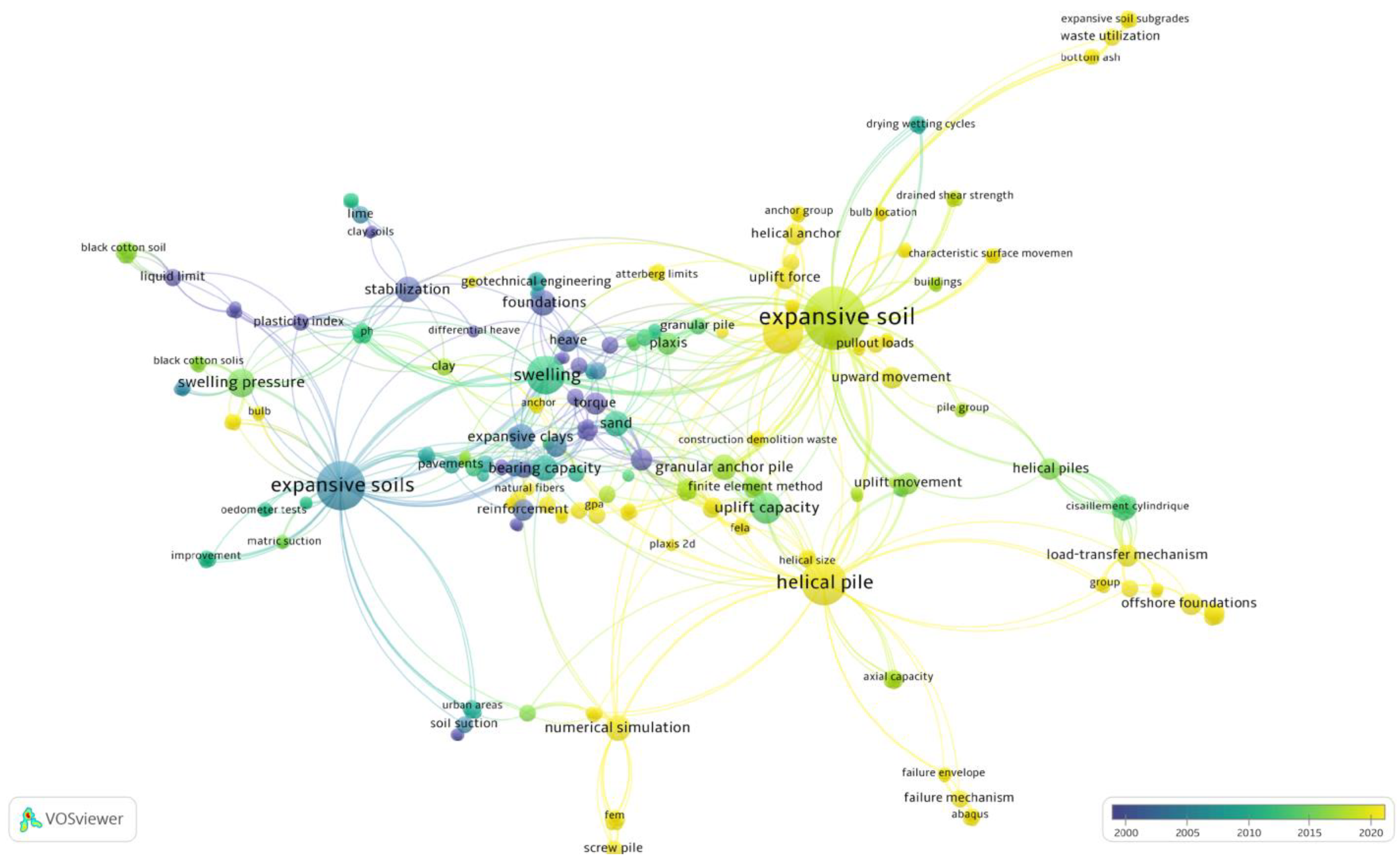
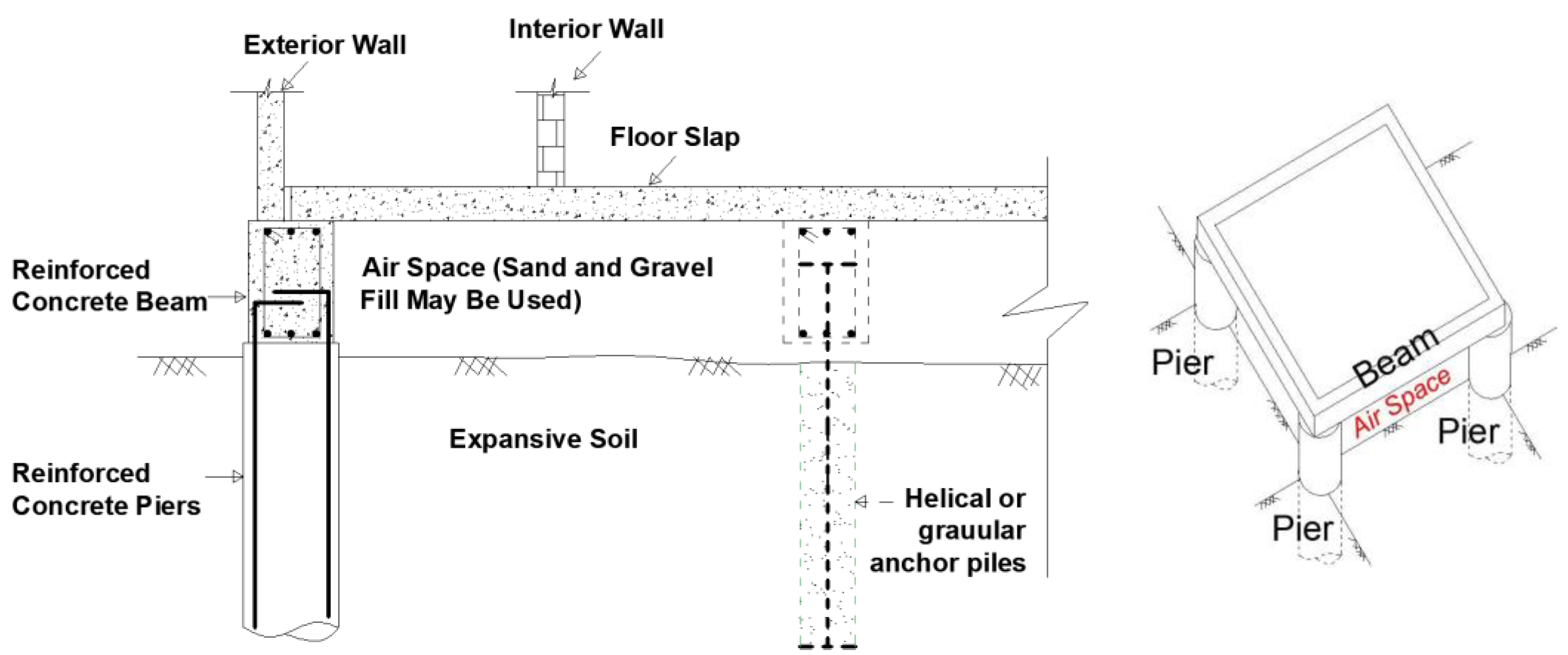





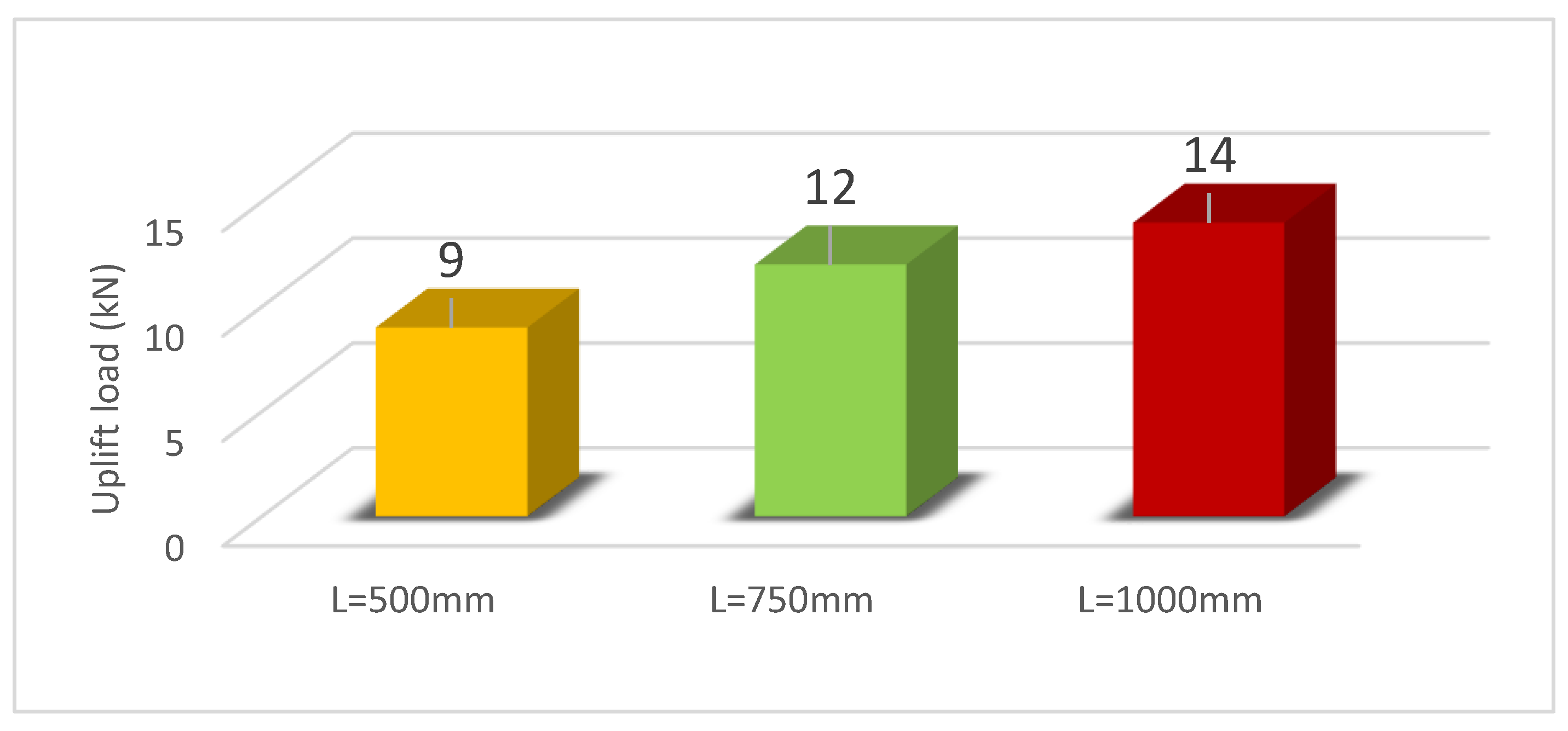


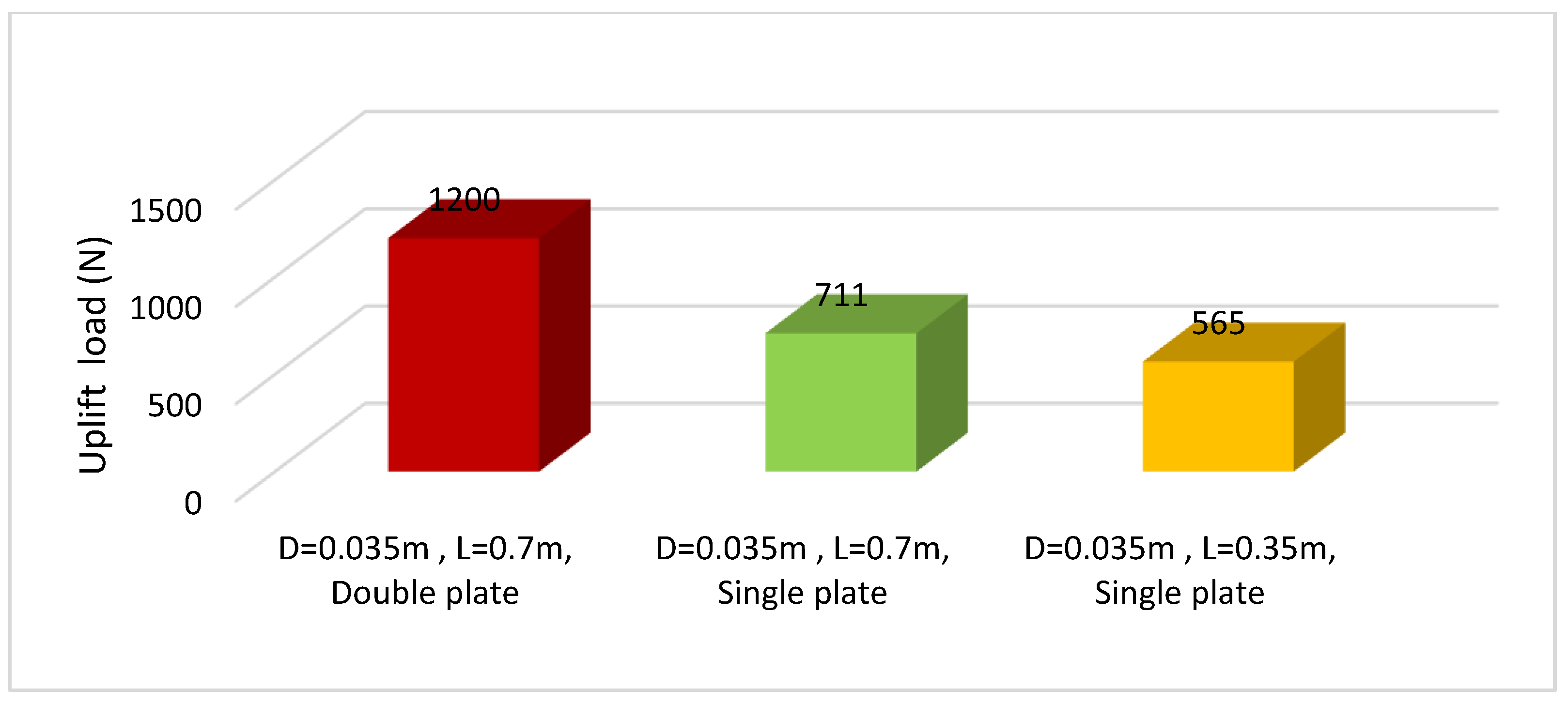
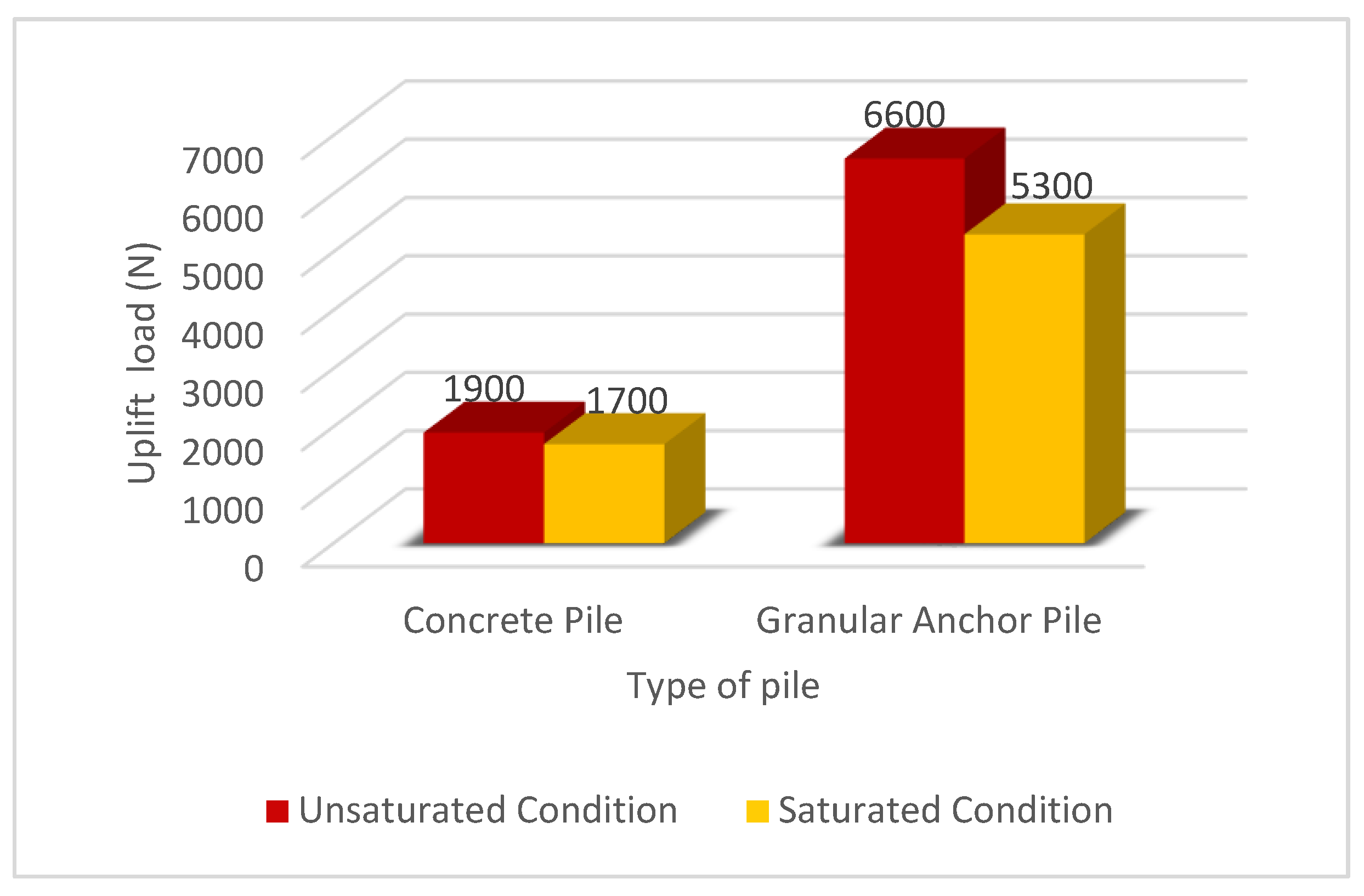
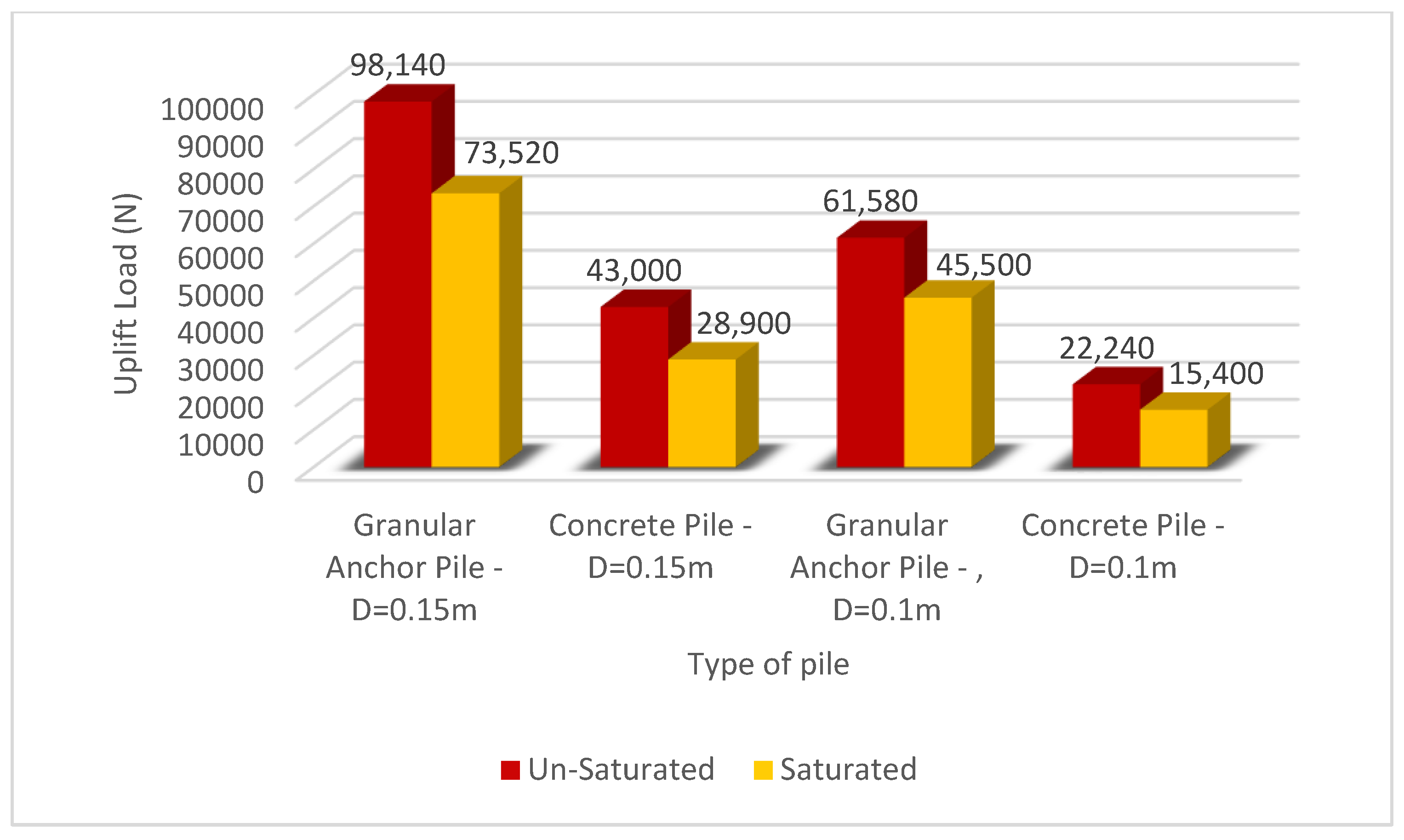
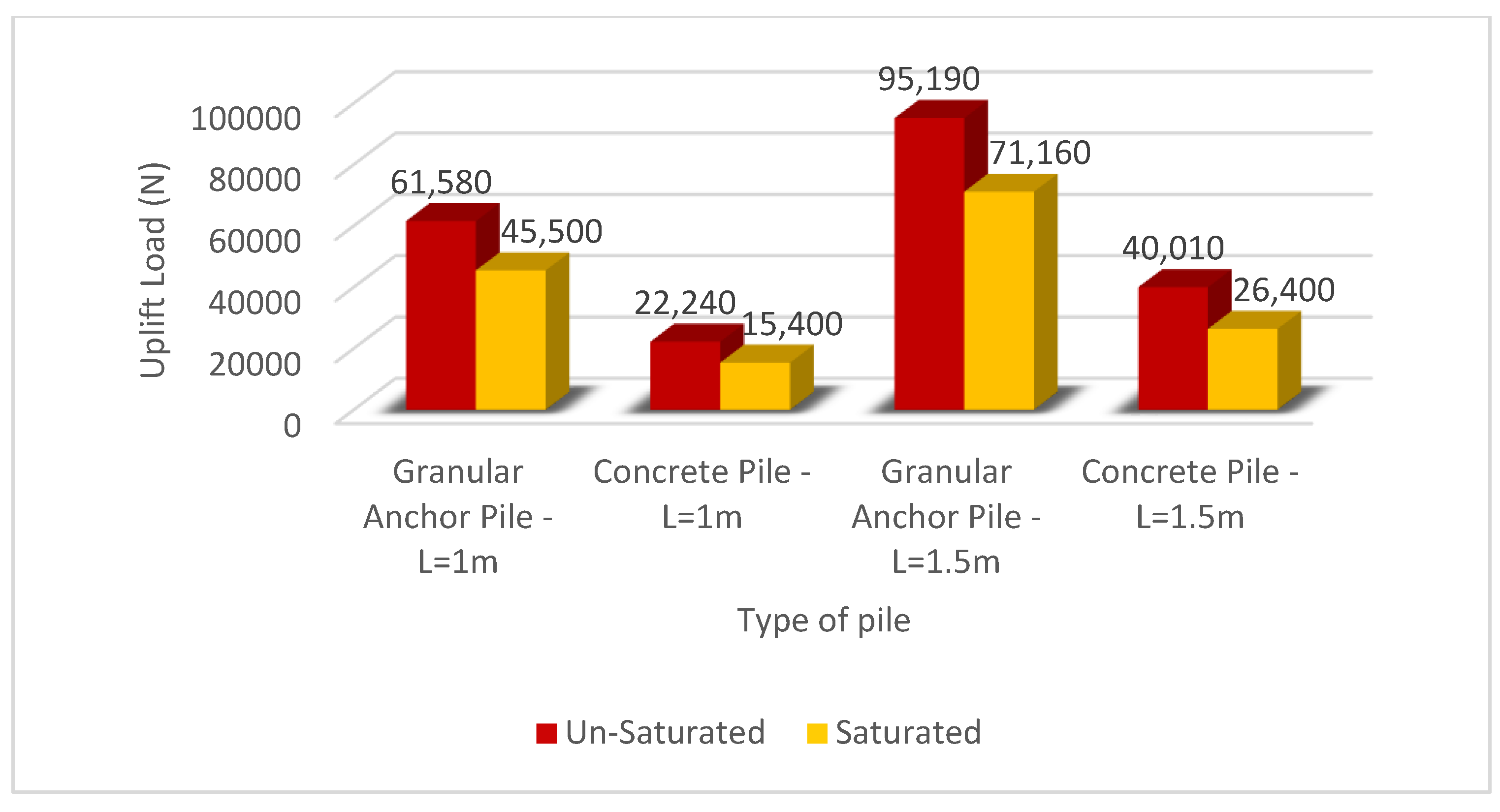


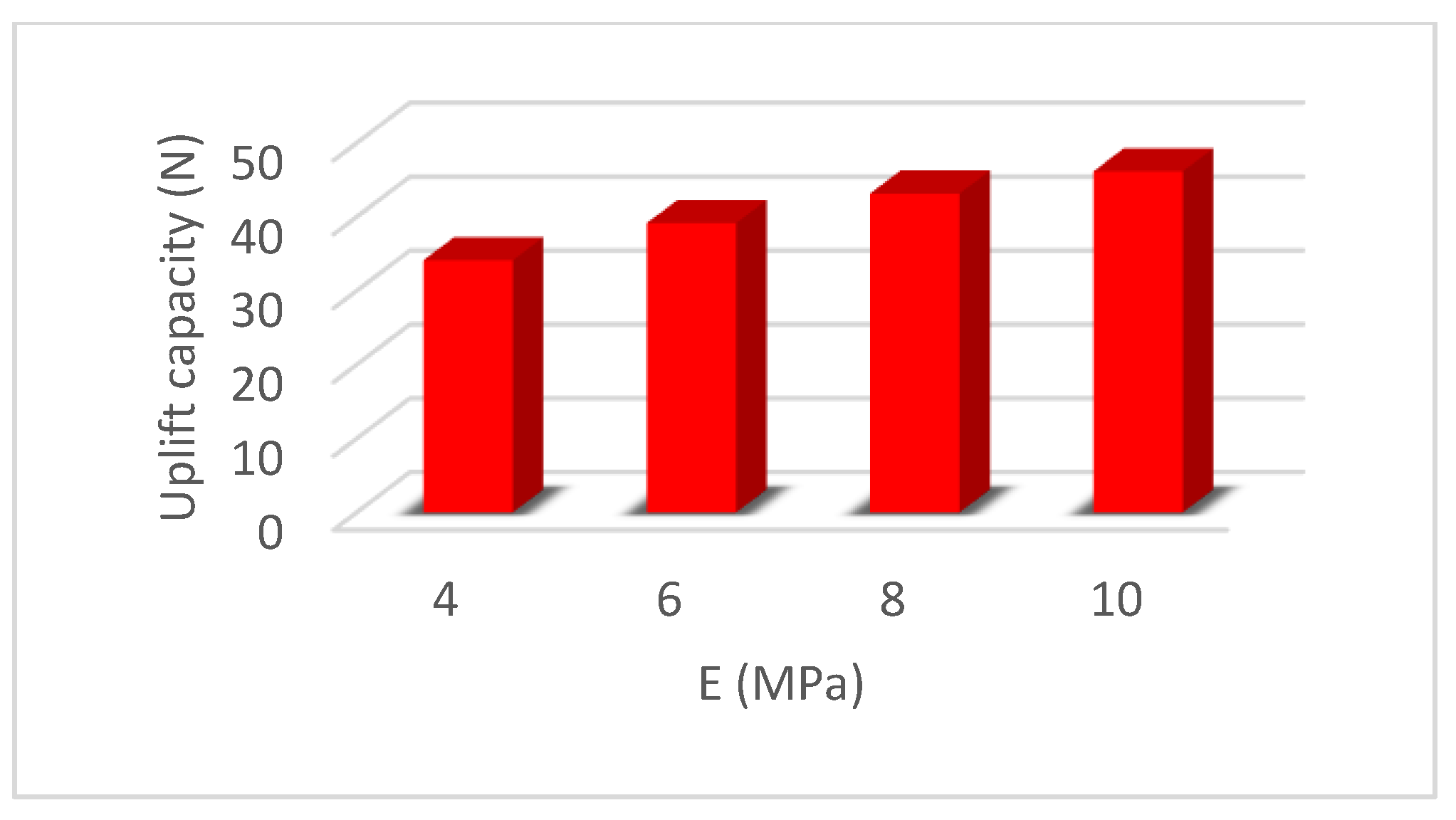

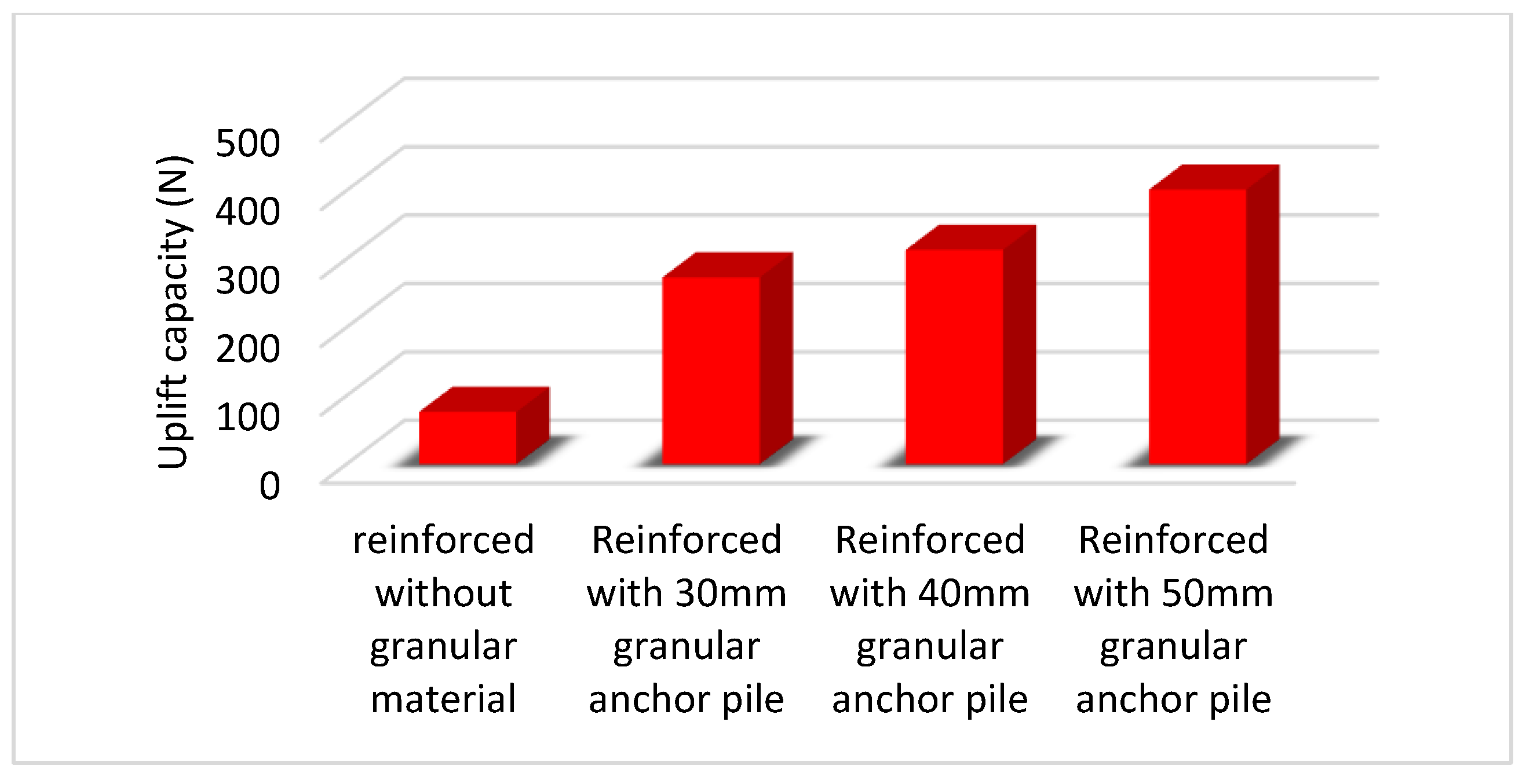
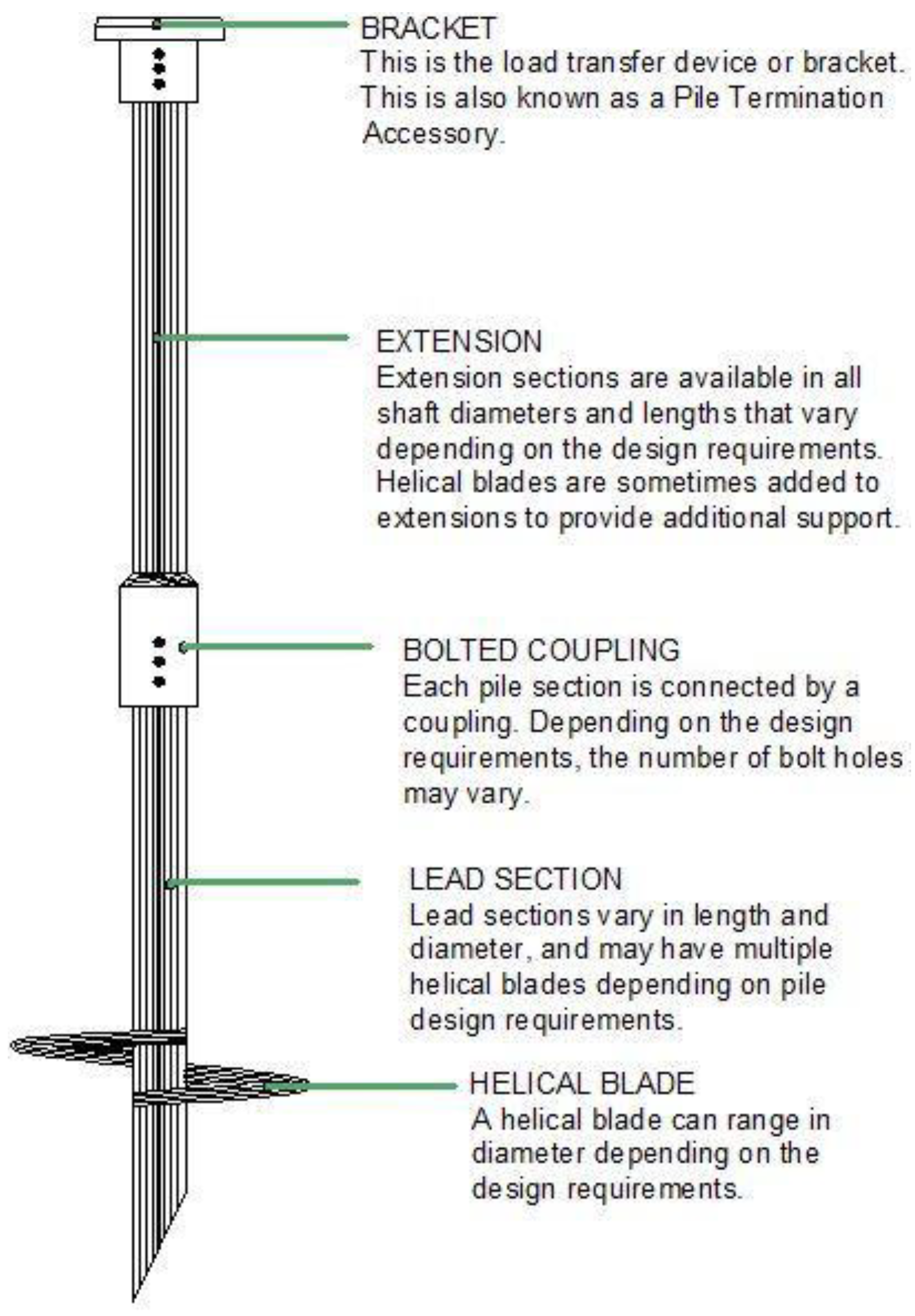
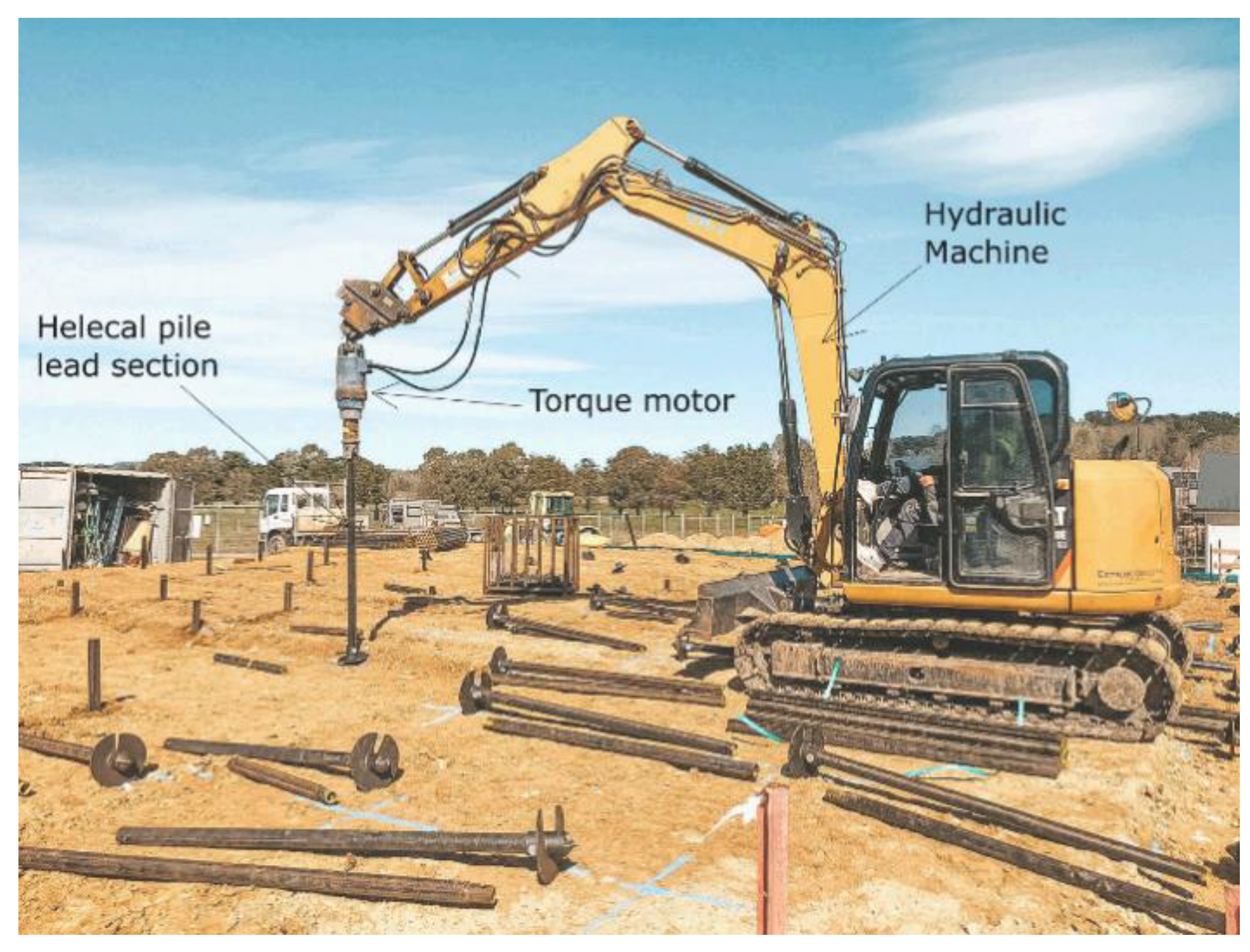
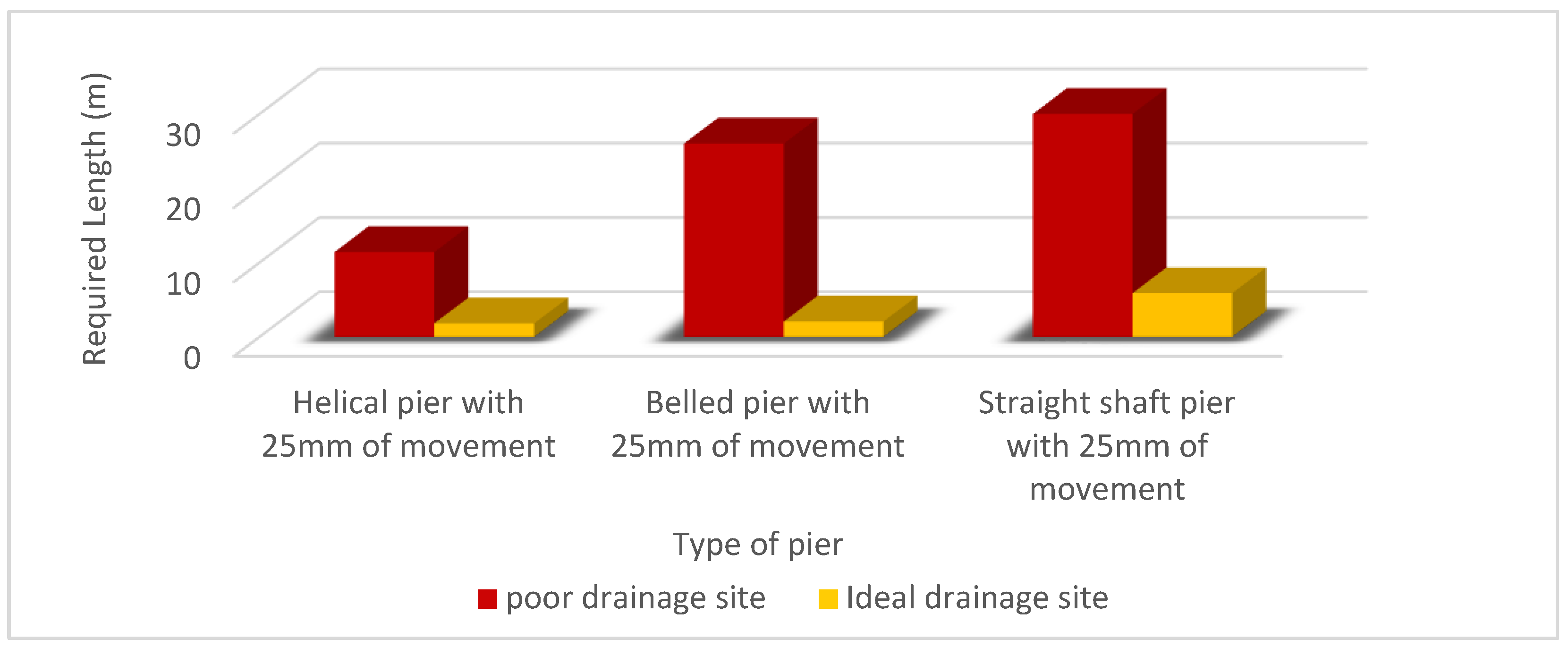
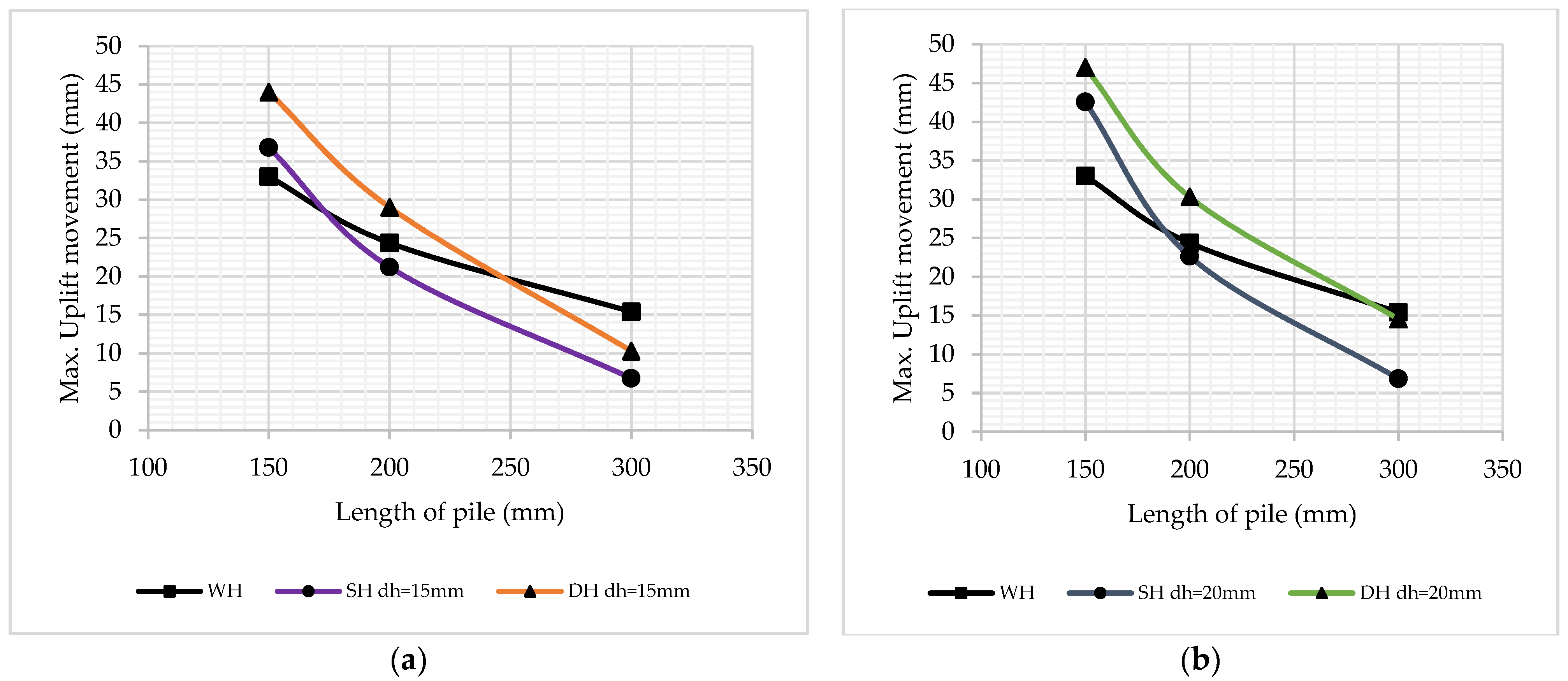

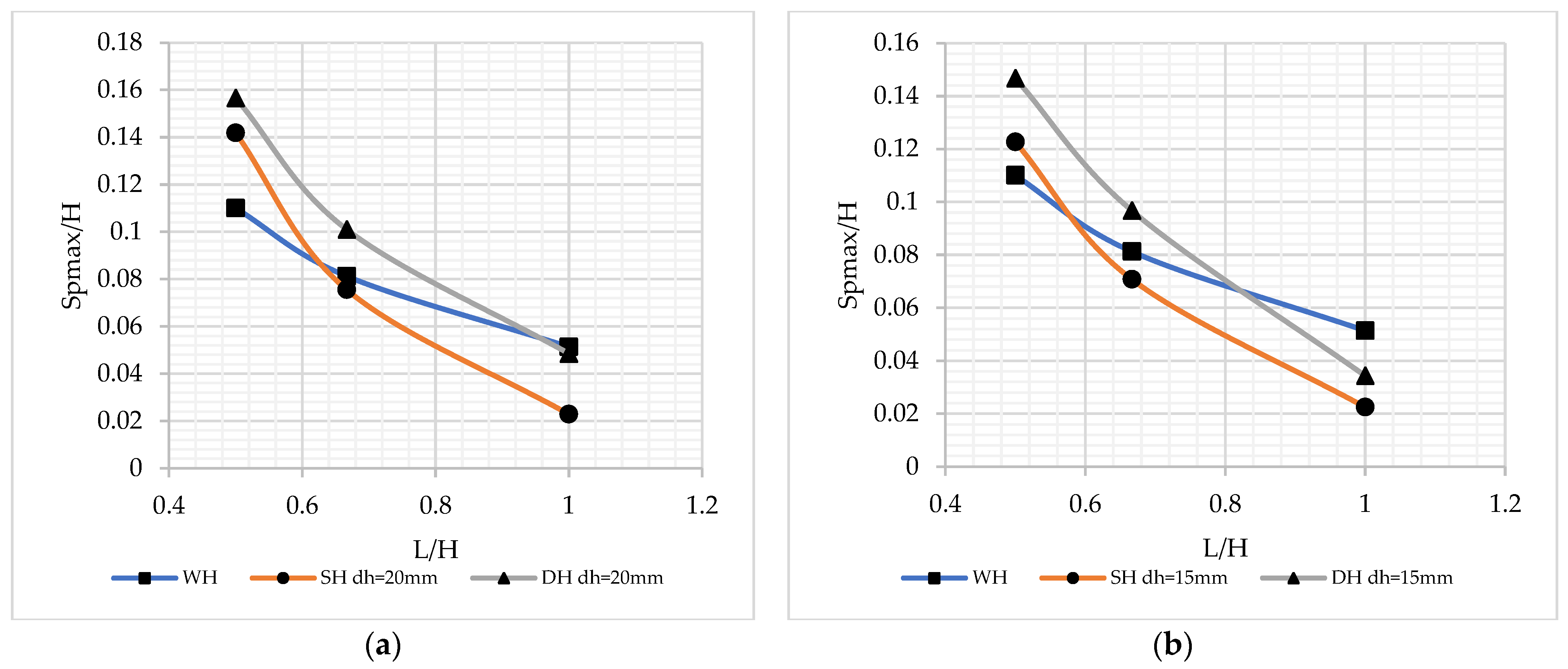
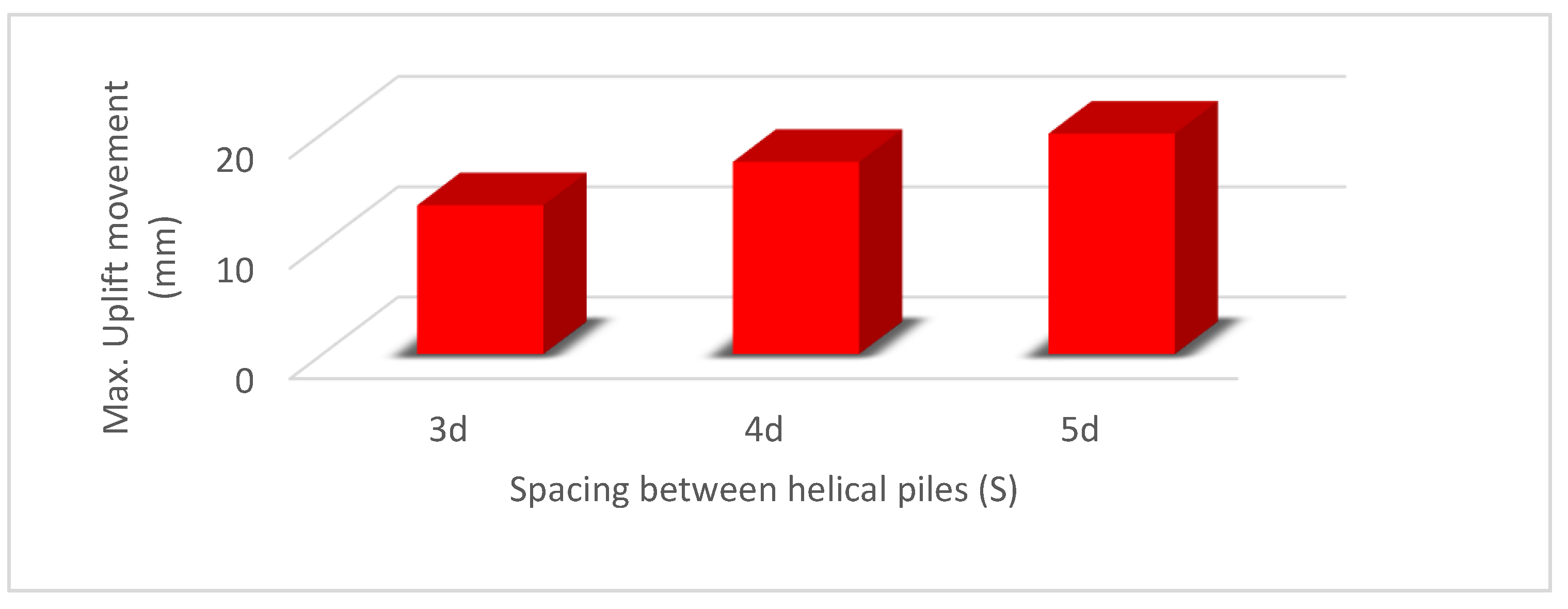


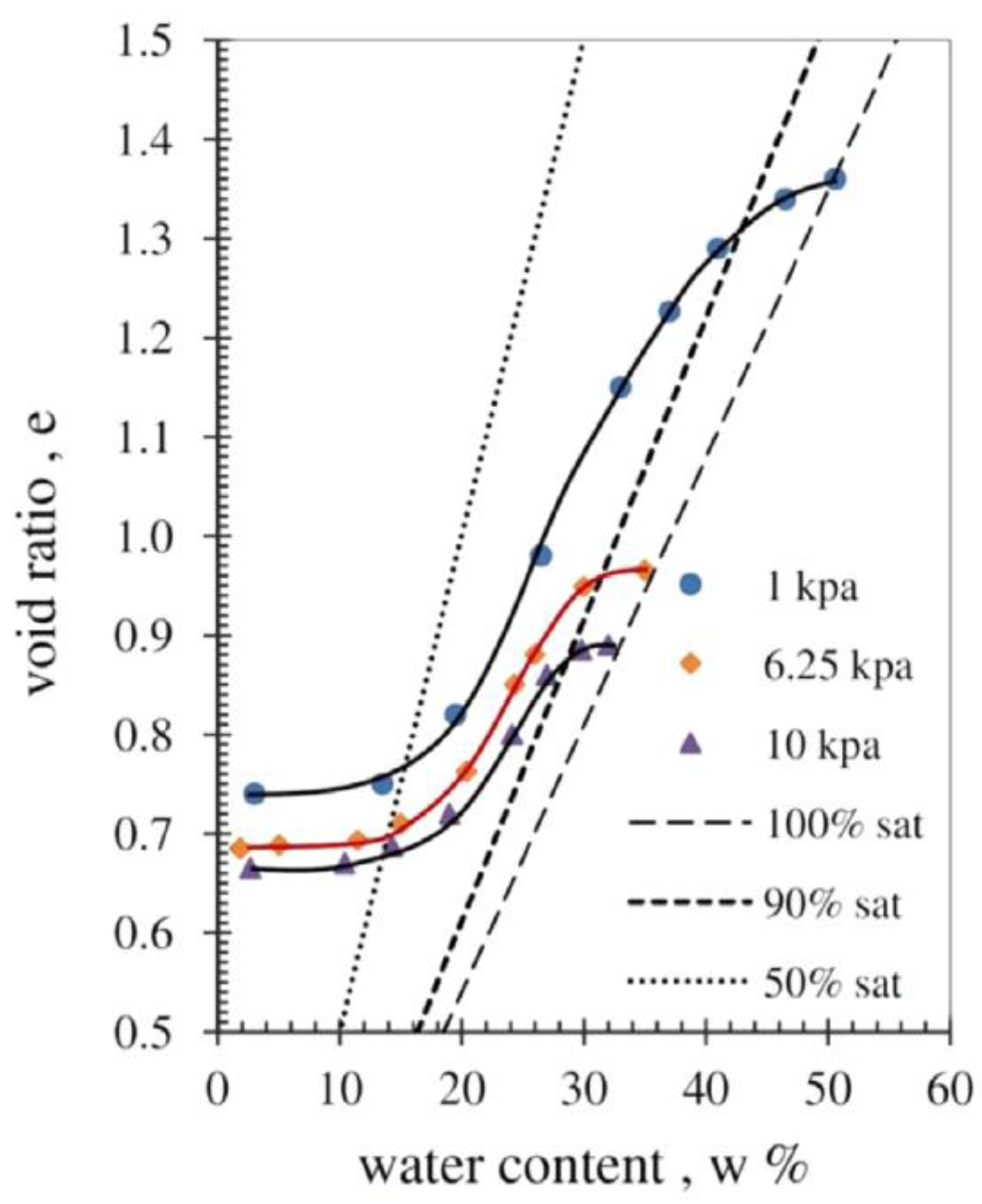
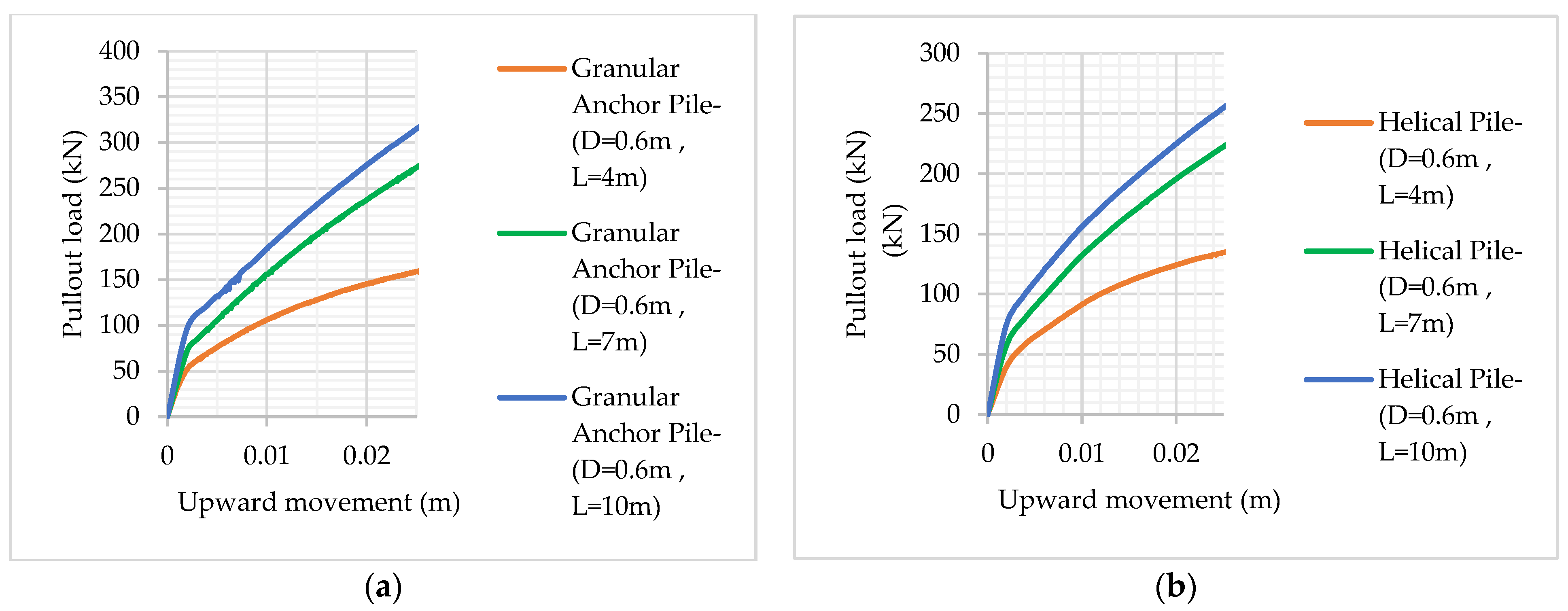
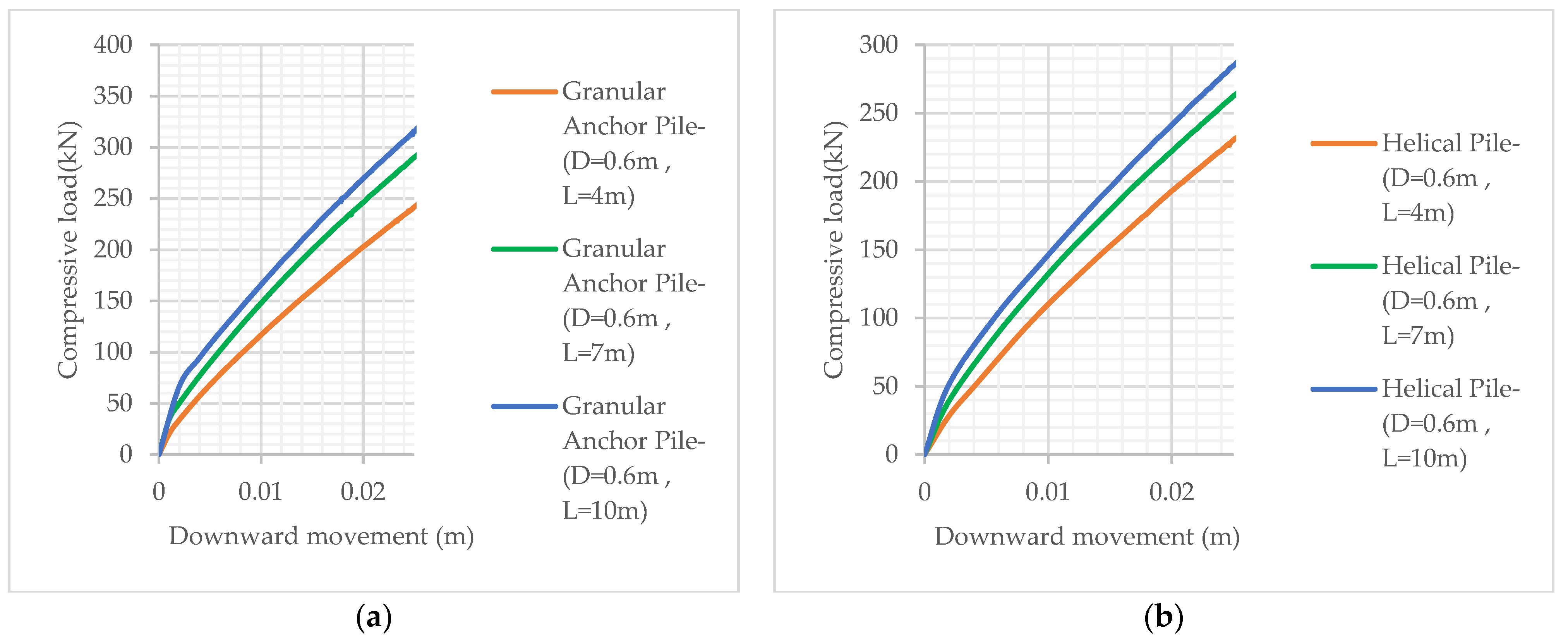





| Application | Helical Piles | Granular Anchor Piles |
|---|---|---|
| Retaining Walls | ✔ | under base only |
| Slope and Landslide Stabilization | ✔ | X |
| Tie-down Structures (concrete dam, offshore wind, uplift slab) | ✔ | ✔ |
| Liquid Limit (LL%) | Plasticity Index (PI%) | Potential for Volume Change |
|---|---|---|
| 20–35 | <18 | Low |
| 35–50 | 15–28 | Medium |
| 50–70 | 25–41 | High |
| >70 | >35 | Very high |
| Liquid Limit (LL%) | Plasticity Index (PI%) | Soil Suction (kPa) | Potential for Volume Change |
|---|---|---|---|
| <50 | <25 | <144 | Low |
| 50–60 | 25–35 | 144–383 | Medium |
| >60 | >35 | >383 | High |
| Type of Foundation | Philosophy of Design | Advantages | Disadvantages |
|---|---|---|---|
| Pier, helical pile, or Granular anchor pile and beam (Figure 2) | Isolate structure from expansive movement by mitigating swell using anchoring to create stable layers | Utilized in a wide range of soils; effective in high-swell potential soils | The design and construction processes are relatively complex. Specialized contractors are required. |
| Raft or stiffened raft | Protects the structure from differential settlements by providing a rigid foundation. | Reliable on soils with a moderate swell potential; no special building equipment is required. | Only works for building relatively simple layouts; comprehensive construction quality control is required. |
| Modified continuous perimeter footing or deep trench fill foundations | Same as raft or stiffened raft foundation—includes stiffened perimeter beams. | No specialized equipment is required for this simple construction. | Ineffective in highly expansive soils or tree-influenced zones. |
| Type of Mat | Beam Depth, cm | Beam Spacing, m |
|---|---|---|
| Light | 40 to 50 | 6 to 4.5 |
| Medium | 50 to 65 | 4.5 to 3.6 |
| Heavy | 65 to 75 | 4.5 to 3.6 |
| Classification | Type | Description |
|---|---|---|
| Displacement | Timber Precast concrete Steel circular/rectangular Tapered timber/steel | Driven piles have a solid circular or rectangular cross-section or a closed bottom end. Piles that have been hammered or jacked into position |
| Small displacement | Precast concrete Prestressed concrete Steel H section Steel circular/rectangular Screw (helical pile) | Open-end cylinder, rectangular, H section, or screw configuration pile with a small cross-section |
| Nondisplacement | Drilled shaft Tubes filled with concrete Precast concrete Injected cement mortar Steel section Granular anchor pile | Piles of concrete are placed in open boreholes drilled by using a rotary auger, baling, grabbing, airlift, or reverse circulation methods. |
| Diameter (D) (m) | Granular Anchor Pile Length (L) (m) | Cap Width (B) (m) |
|---|---|---|
| 0.6 | 4 | 1 |
| 7 | ||
| 10 |
| Model Parameter | Expansive Soil (Undrained Behavior) | Sand (Drained Behavior) | Granular (Drained Behavior) |
|---|---|---|---|
| (kN/m3) | 15.3 | 16 | 19 |
| (kN/m3) | 18.4 | 19 | 21 |
| (kN/m2) | 5000 | 40,000 | 50,000 |
| (kN/m2) | 5000 | 40,000 | 50,000 |
| (kN/m2) | 15,000 | 120,000 | 150,000 |
| C′ (kN/m2) | 17 | 0.1 | 0.1 |
| ′ (°) | 20 | 37 | 38 |
| (°) | 0 | 7 | 8 |
| (−) | 0.3 | 0.25 | 0.2 |
| m (−) | 1 | 0.5 | 0.5 |
| Model Parameter | Helix Plate (Linear Elastic) | Shaft (Linear Elastic) | Concrete Foot (Linear Elastic) |
|---|---|---|---|
| Unit weight (kN/m3) | 78 | 78 | 24 |
| E (kN/m2) | 200,000,000 | 200,000,000 | 30,000,000 |
| v (−) | 0.3 | 0.3 | 0.15 |
| Thickness (m) | 0.01 | - | 0.5 |
| Dimension (m) | - | 0.1 × 0.1 | 1 × 1 |
| Model Parameter | Expansive Soil (Undrained Behavior) | Sand (Drained Behavior) |
|---|---|---|
| (kN/m3) | 15.3 | 16 |
| (kN/m3) | 18.4 | 19 |
| (kN/m2) | 3500 | 20,000 |
| (kN/m2) | 3500 | 20,000 |
| (kN/m2) | 10,500 | 60,000 |
| C′ (kN/m2) | 8 | 0.1 |
| ′ (°) | 19 | 30 |
| (°) | 0 | 1 |
| (−) | 0.3 | 0.25 |
| m (−) | 1 | 0.5 |
| L (m) | GAP Pullout Load (kN) | HP Pullout Load (kN) | (GAP-HP)/HP (%) |
|---|---|---|---|
| 4 | 159 | 135 | 17.8 |
| 7 | 271 | 222 | 22.1 |
| 10 | 315 | 253 | 24.5 |
| L (m) | GAP Capacity (kN) | HP Capacity (kN) | (GAP-HP)/HP (%) |
|---|---|---|---|
| 4 | 241 | 230 | 4.8 |
| 7 | 290 | 262 | 10.7 |
| 10 | 315 | 284 | 10.9 |
| Reduction Heave of Helical Pile (%) | Reduction Heave of Granular Anchor Pile (%) | Heave (m) | Length (m) | Case | ||
|---|---|---|---|---|---|---|
| Unreinforced Soil | Helical Pile | Granular Anchor Pile | ||||
| 54.9 | 51.7 | 0.268 | 0.121 | 0.129 | 4 | Case-1- |
| 92.6 | 92.2 | 0.268 | 0.020 | 0.021 | 7 | |
| 94.0 | 93.0 | 0.268 | 0.016 | 0.019 | 10 | |
| 78.6 | 71.7 | 0.260 | 0.055 | 0.073 | 4 | Case-2- |
| 95.1 | 95.7 | 0.260 | 0.013 | 0.011 | 7 | |
| 96.3 | 97.0 | 0.260 | 0.010 | 0.008 | 10 | |
| Property | Granular Anchor Pile | Helical Pile | Straight Shaft Piles | Under-Reamed Piles |
|---|---|---|---|---|
| Pullout load | Excellent | Good | Fair | Good |
| Downward load | Fair | Poor | Good | Excellent |
| Heave | Excellent | Excellent | Good | Very good |
| Combining concrete elements | Good | Good | Very good | Very good |
| Cost | Inexpensive | Expensive | Moderately Inexpensive | Moderately Expensive |
| Damage during installation | No Damage | Exposed to damage | No damage | No damage |
| lateral loads | Weak | Weaker | Good | Good |
| Type of load transfer | Tip resistance and skin friction | Tip resistance | Skin friction and tip resistance | Tip resistance and skin friction |
| Direction of installation | Vertical direction | All directions | Vertical direction | Vertical direction |
| Installation time | Installed with no cure time, allowing for quick project implementation. | Installed with no cure time, allowing for quick project implementation. | Concrete takes 2–4 weeks to cure. | Concrete takes 2–4 weeks to cure. |
| Environmental Effects | Steel can be removed and reused, reducing waste. | Steel can be removed and reused, reducing waste. | Non-reusable after installation. | Non-reusable after installation. |
Disclaimer/Publisher’s Note: The statements, opinions and data contained in all publications are solely those of the individual author(s) and contributor(s) and not of MDPI and/or the editor(s). MDPI and/or the editor(s) disclaim responsibility for any injury to people or property resulting from any ideas, methods, instructions or products referred to in the content. |
© 2023 by the authors. Licensee MDPI, Basel, Switzerland. This article is an open access article distributed under the terms and conditions of the Creative Commons Attribution (CC BY) license (https://creativecommons.org/licenses/by/4.0/).
Share and Cite
Alnmr, A.; Ray, R.P.; Alsirawan, R. A State-of-the-Art Review and Numerical Study of Reinforced Expansive Soil with Granular Anchor Piles and Helical Piles. Sustainability 2023, 15, 2802. https://doi.org/10.3390/su15032802
Alnmr A, Ray RP, Alsirawan R. A State-of-the-Art Review and Numerical Study of Reinforced Expansive Soil with Granular Anchor Piles and Helical Piles. Sustainability. 2023; 15(3):2802. https://doi.org/10.3390/su15032802
Chicago/Turabian StyleAlnmr, Ammar, Richard Paul Ray, and Rashad Alsirawan. 2023. "A State-of-the-Art Review and Numerical Study of Reinforced Expansive Soil with Granular Anchor Piles and Helical Piles" Sustainability 15, no. 3: 2802. https://doi.org/10.3390/su15032802
APA StyleAlnmr, A., Ray, R. P., & Alsirawan, R. (2023). A State-of-the-Art Review and Numerical Study of Reinforced Expansive Soil with Granular Anchor Piles and Helical Piles. Sustainability, 15(3), 2802. https://doi.org/10.3390/su15032802








